The Leading All-in-One Automated and Manual Software Testing Platform
Everything you need for functional software testing, in one place.
Source: Gartner Peer Reviews

















































































The Primary Components of AscentialTest®
Test frameworks are costly to build and maintain. Unlike keyword-driven testing, AscentialTest does not require the development of a test framework. AscentialTest is a productivity tool for software testing. It has been designed to lower the learning curve, reduce test creation time and minimize the level of effort to maintain tests. Instead of investing time in building frameworks, software testers can spend more time testing. AscentialTest provides a highly visual environment where test components are created using drag and drop in an easy 4 step process
Users point and click to capture Snapshots, which contain all of the data required to expose and organize application objects and attributes. Users define objects by dragging and dropping to the object repository.
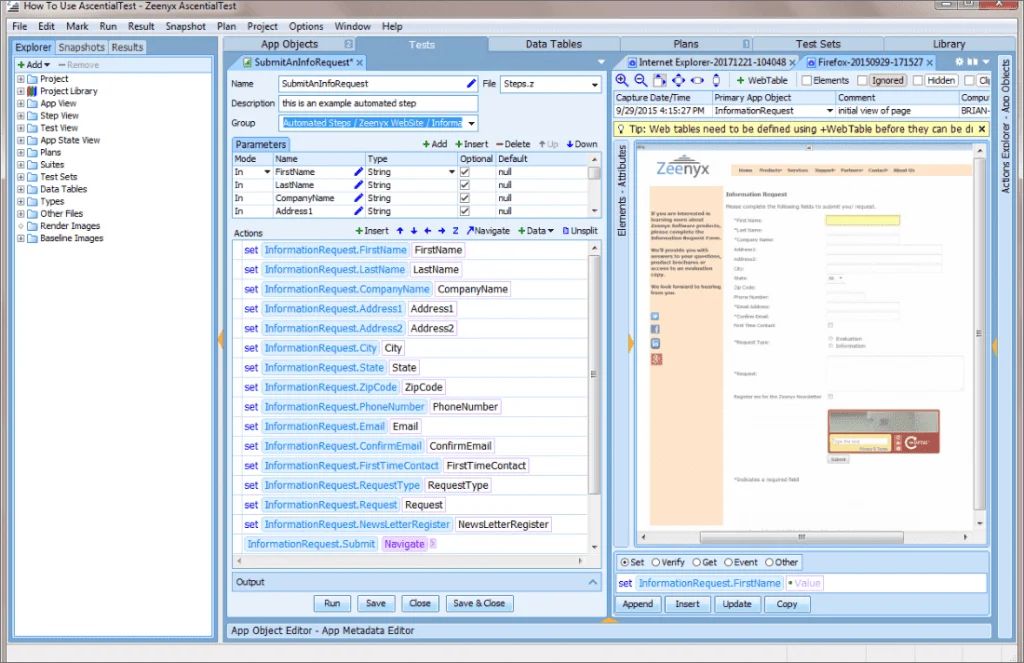
AscentialTest marries the usability of a recorder with the strength of script-based testing. Reusable steps are created by point and click. Actions are automatically generated by interacting with Snapshots.
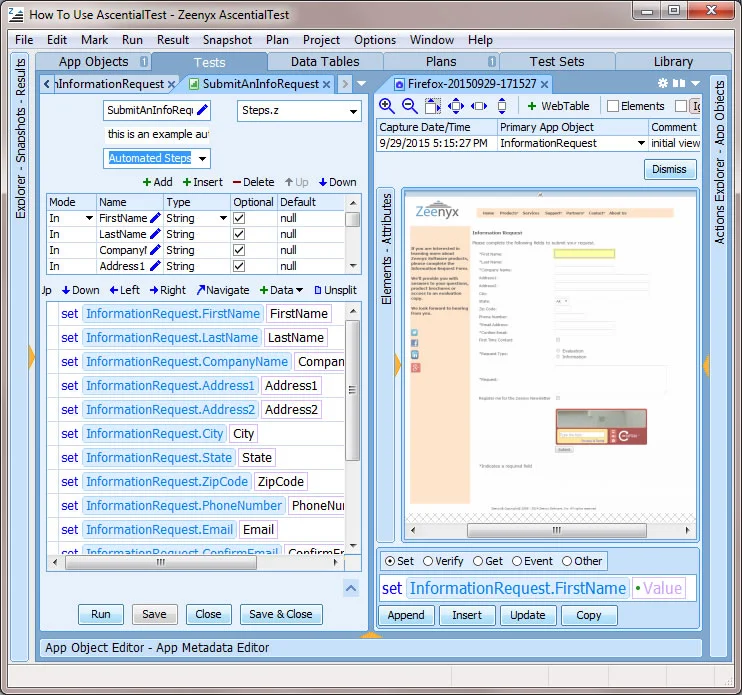
Reusable tests are built by dragging and dropping steps. AscentialTest automatically generates data tables and binds to the data fields of the test. As the library of steps grows, the pace of building new tests accelerates. The most important benefit of the Step-Based approach is not realized until the target application changes over time. When the target application changes, only the impacted steps need to be modified. All the tests that use those steps are automatically updated. This not only saves time and resources, it assures that tests are ready when you need them.
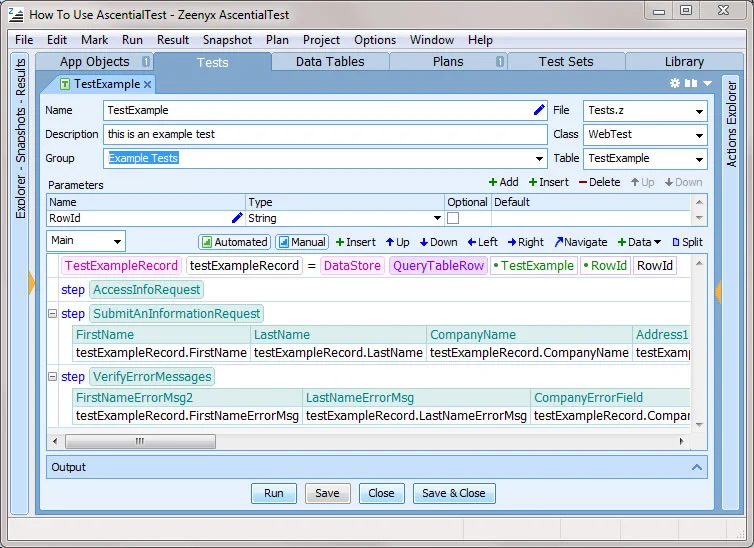
Data tables are automatically generated by AscentialTest based on test input fields. Data tables offer significant advantages over spreadsheets for maintaining test data. Instead of storing only strings, AscentialTest data tables store data in the type that is required by test actions including complex lists and records. Users can automatically generate data tables from tests or build them visually using a specialized editor. All the user has to do is provide the test data.

Users point and click to capture Snapshots, which contain all of the data required to expose and organize application objects and attributes. Users define objects by dragging and dropping to the object repository.

AscentialTest marries the usability of a recorder with the strength of script-based testing. Reusable steps are created by point and click. Actions are automatically generated by interacting with Snapshots.

Reusable tests are built by dragging and dropping steps. AscentialTest automatically generates data tables and binds to the data fields of the test. As the library of steps grows, the pace of building new tests accelerates. The most important benefit of the Step-Based approach is not realized until the target application changes over time. When the target application changes, only the impacted steps need to be modified. All the tests that use those steps are automatically updated. This not only saves time and resources, it assures that tests are ready when you need them.

Data tables are automatically generated by AscentialTest based on test input fields. Data tables offer significant advantages over spreadsheets for maintaining test data. Instead of storing only strings, AscentialTest data tables store data in the type that is required by test actions including complex lists and records. Users can automatically generate data tables from tests or build them visually using a specialized editor. All the user has to do is provide the test data.

AscentialTest provides a unique way to create and execute manual tests. Manual tests are developed by combining and organizing re-usable steps by drag and drop. At test execution time, the tester is prompted with instructions for each step and provided a way to capture outputs, notes, images and attachments. Results are stored along with automated test results, making it easy to generate comprehensive reports. AscentialTest provides a highly visual environment where test components are created using drag and drop in an easy 4 step process
Build reusable steps to reduce test maintenance when the target application changes in the future.

Reusable tests are built by dragging and dropping steps. AscentialTest automatically generates data tables and binds to the data fields of the test. As the library of steps grows, the pace of building new tests accelerates. The most important benefit of the Step-Based approach is not realized until the target application changes over time. When the target application changes, only the impacted steps need to be modified. All the tests that use those steps are automatically updated. This not only saves time and resources, it assures that tests are ready when you need them.
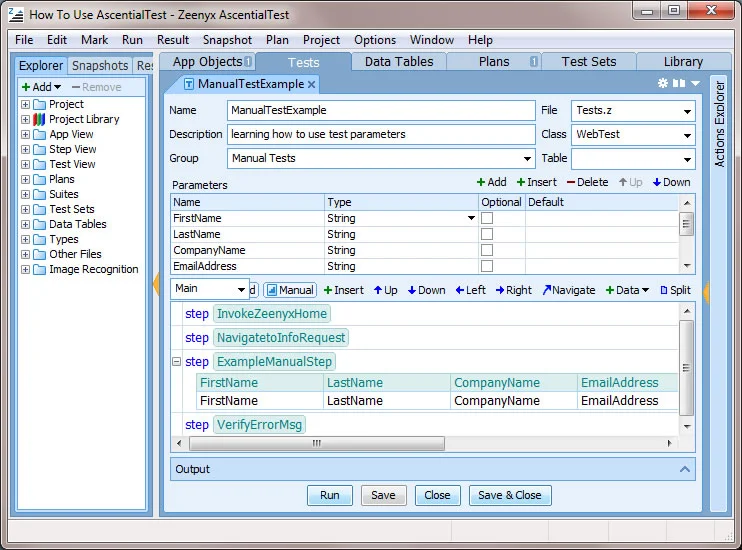
Data tables are automatically generated by AscentialTest based on test input fields. Data tables offer significant advantages over spreadsheets for maintaining test data. Instead of storing only strings, AscentialTest data tables store data in the type that is required by test actions including complex lists and records. Users can automatically generate data tables from tests or build them visually using a specialized editor. All the user has to do is provide the test data.

The manual test prompter invokes on the tester’s computer and provides instructions along with the ability to capture outputs, notes and attachments.
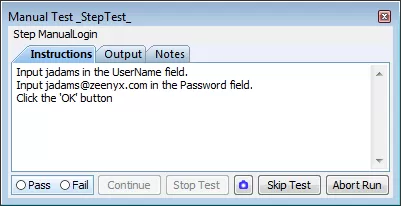
Build reusable steps to reduce test maintenance when the target application changes in the future.

Reusable tests are built by dragging and dropping steps. AscentialTest automatically generates data tables and binds to the data fields of the test. As the library of steps grows, the pace of building new tests accelerates. The most important benefit of the Step-Based approach is not realized until the target application changes over time. When the target application changes, only the impacted steps need to be modified. All the tests that use those steps are automatically updated. This not only saves time and resources, it assures that tests are ready when you need them.

Data tables are automatically generated by AscentialTest based on test input fields. Data tables offer significant advantages over spreadsheets for maintaining test data. Instead of storing only strings, AscentialTest data tables store data in the type that is required by test actions including complex lists and records. Users can automatically generate data tables from tests or build them visually using a specialized editor. All the user has to do is provide the test data.

The manual test prompter invokes on the tester’s computer and provides instructions along with the ability to capture outputs, notes and attachments.

AscentialTest is designed to make it easy to manage test plans, test data, manual and automated tests, test results and metrics. It supports collaborations and integrates easily with version control, defect tracking and continuous delivery solutions.
The Test Plan Editor is a planning tool used to describe test requirements in outline, list or scenario form. It provides links to manual and automated tests and to test data stored in built-in data tables.
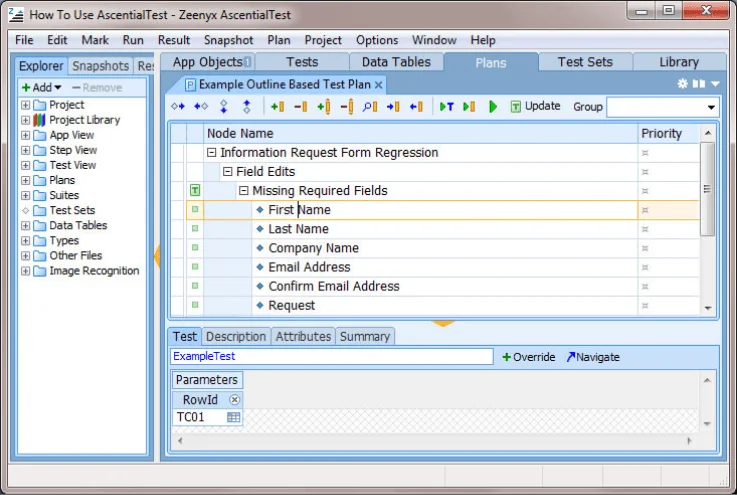
AscentialTest is integrated with Jira for defect tracking to provide a way to manage the relationship between test results and defects. (Figure 1)
Failures can be associated with defects so that testers will be notified when defects have been fixed and ready for re-testing. (Figure 2)
AscentialTest offers several collaboration features by integrating seamlessly with other software development tools. By integrating with version control systems like Subversion (SVN), large teams can contribute to the test development effort. Integration with GIT and TFS will also be offered in the near future.

Test Sets provide test execution management and reporting. A Test Set may be created for a build, a sprint, a test cycle or a project, depending upon how your organization tests and delivers software. Test Sets help manage test results.
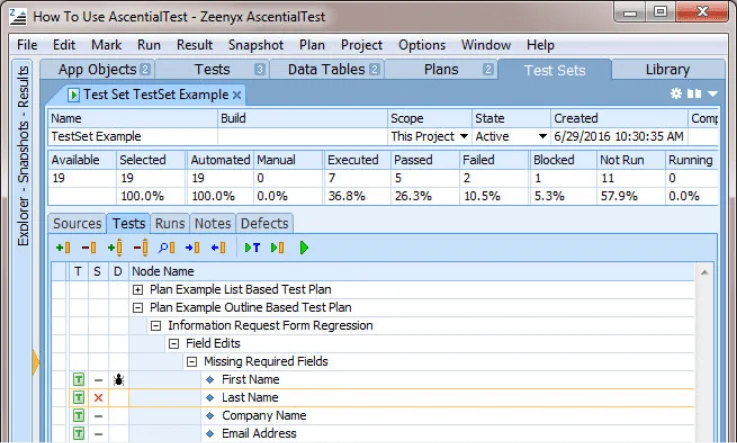

The Test Plan Editor is a planning tool used to describe test requirements in outline, list or scenario form. It provides links to manual and automated tests and to test data stored in built-in data tables.

AscentialTest is integrated with Jira for defect tracking to provide a way to manage the relationship between test results and defects. (Figure 1)
Failures can be associated with defects so that testers will be notified when defects have been fixed and ready for re-testing. (Figure 2)
AscentialTest offers several collaboration features by integrating seamlessly with other software development tools. By integrating with version control systems like Subversion (SVN), large teams can contribute to the test development effort. Integration with GIT and TFS will also be offered in the near future.

Test Sets provide test execution management and reporting. A Test Set may be created for a build, a sprint, a test cycle or a project, depending upon how your organization tests and delivers software. Test Sets help manage test results.


AscentialTest makes it easy to mange test data and integrate it with manual and automated tests.
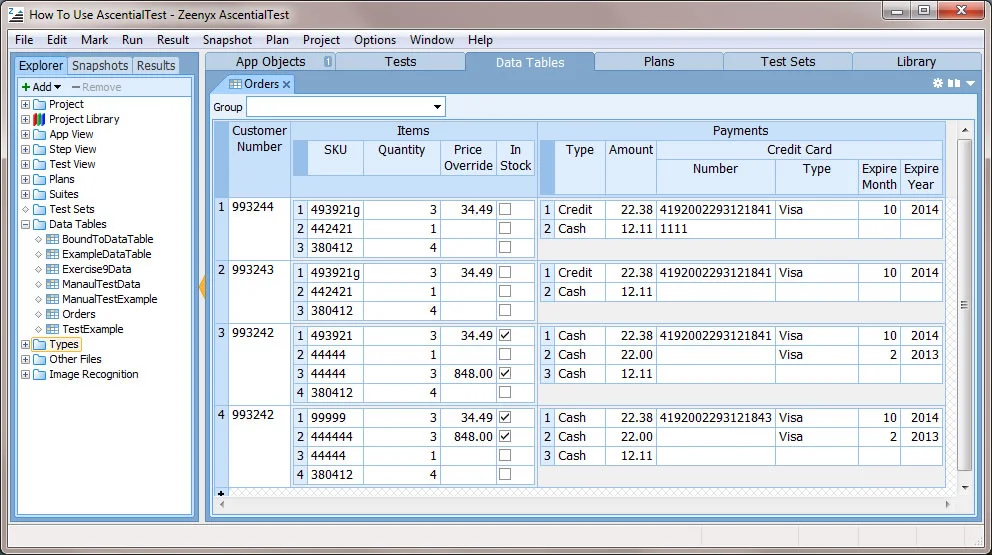
Test frameworks are costly to build and maintain. Unlike keyword-driven testing, AscentialTest does not require the development of a test framework. AscentialTest is a productivity tool for software testing. It has been designed to lower the learning curve, reduce test creation time and minimize the level of effort to maintain tests. Instead of investing time in building frameworks, software testers can spend more time testing. AscentialTest provides a highly visual environment where test components are created using drag and drop in an easy 4 step process
Users point and click to capture Snapshots, which contain all of the data required to expose and organize application objects and attributes. Users define objects by dragging and dropping to the object repository.

AscentialTest marries the usability of a recorder with the strength of script-based testing. Reusable steps are created by point and click. Actions are automatically generated by interacting with Snapshots.

Reusable tests are built by dragging and dropping steps. AscentialTest automatically generates data tables and binds to the data fields of the test. As the library of steps grows, the pace of building new tests accelerates. The most important benefit of the Step-Based approach is not realized until the target application changes over time. When the target application changes, only the impacted steps need to be modified. All the tests that use those steps are automatically updated. This not only saves time and resources, it assures that tests are ready when you need them.

Data tables are automatically generated by AscentialTest based on test input fields. Data tables offer significant advantages over spreadsheets for maintaining test data. Instead of storing only strings, AscentialTest data tables store data in the type that is required by test actions including complex lists and records. Users can automatically generate data tables from tests or build them visually using a specialized editor. All the user has to do is provide the test data.

Users point and click to capture Snapshots, which contain all of the data required to expose and organize application objects and attributes. Users define objects by dragging and dropping to the object repository.

AscentialTest marries the usability of a recorder with the strength of script-based testing. Reusable steps are created by point and click. Actions are automatically generated by interacting with Snapshots.

Reusable tests are built by dragging and dropping steps. AscentialTest automatically generates data tables and binds to the data fields of the test. As the library of steps grows, the pace of building new tests accelerates. The most important benefit of the Step-Based approach is not realized until the target application changes over time. When the target application changes, only the impacted steps need to be modified. All the tests that use those steps are automatically updated. This not only saves time and resources, it assures that tests are ready when you need them.

Data tables are automatically generated by AscentialTest based on test input fields. Data tables offer significant advantages over spreadsheets for maintaining test data. Instead of storing only strings, AscentialTest data tables store data in the type that is required by test actions including complex lists and records. Users can automatically generate data tables from tests or build them visually using a specialized editor. All the user has to do is provide the test data.

AscentialTest provides a unique way to create and execute manual tests. Manual tests are developed by combining and organizing re-usable steps by drag and drop. At test execution time, the tester is prompted with instructions for each step and provided a way to capture outputs, notes, images and attachments. Results are stored along with automated test results, making it easy to generate comprehensive reports. AscentialTest provides a highly visual environment where test components are created using drag and drop in an easy 4 step process
Build reusable steps to reduce test maintenance when the target application changes in the future.

Reusable tests are built by dragging and dropping steps. AscentialTest automatically generates data tables and binds to the data fields of the test. As the library of steps grows, the pace of building new tests accelerates. The most important benefit of the Step-Based approach is not realized until the target application changes over time. When the target application changes, only the impacted steps need to be modified. All the tests that use those steps are automatically updated. This not only saves time and resources, it assures that tests are ready when you need them.

Data tables are automatically generated by AscentialTest based on test input fields. Data tables offer significant advantages over spreadsheets for maintaining test data. Instead of storing only strings, AscentialTest data tables store data in the type that is required by test actions including complex lists and records. Users can automatically generate data tables from tests or build them visually using a specialized editor. All the user has to do is provide the test data.

The manual test prompter invokes on the tester’s computer and provides instructions along with the ability to capture outputs, notes and attachments.

Build reusable steps to reduce test maintenance when the target application changes in the future.

Reusable tests are built by dragging and dropping steps. AscentialTest automatically generates data tables and binds to the data fields of the test. As the library of steps grows, the pace of building new tests accelerates. The most important benefit of the Step-Based approach is not realized until the target application changes over time. When the target application changes, only the impacted steps need to be modified. All the tests that use those steps are automatically updated. This not only saves time and resources, it assures that tests are ready when you need them.

Data tables are automatically generated by AscentialTest based on test input fields. Data tables offer significant advantages over spreadsheets for maintaining test data. Instead of storing only strings, AscentialTest data tables store data in the type that is required by test actions including complex lists and records. Users can automatically generate data tables from tests or build them visually using a specialized editor. All the user has to do is provide the test data.

The manual test prompter invokes on the tester’s computer and provides instructions along with the ability to capture outputs, notes and attachments.

AscentialTest is designed to make it easy to manage test plans, test data, manual and automated tests, test results and metrics. It supports collaborations and integrates easily with version control, defect tracking and continuous delivery solutions.
The Test Plan Editor is a planning tool used to describe test requirements in outline, list or scenario form. It provides links to manual and automated tests and to test data stored in built-in data tables.

AscentialTest is integrated with Jira for defect tracking to provide a way to manage the relationship between test results and defects. (Figure 1)
Failures can be associated with defects so that testers will be notified when defects have been fixed and ready for re-testing. (Figure 2)
AscentialTest offers several collaboration features by integrating seamlessly with other software development tools. By integrating with version control systems like Subversion (SVN), large teams can contribute to the test development effort. Integration with GIT and TFS will also be offered in the near future.

Test Sets provide test execution management and reporting. A Test Set may be created for a build, a sprint, a test cycle or a project, depending upon how your organization tests and delivers software. Test Sets help manage test results.


The Test Plan Editor is a planning tool used to describe test requirements in outline, list or scenario form. It provides links to manual and automated tests and to test data stored in built-in data tables.

AscentialTest is integrated with Jira for defect tracking to provide a way to manage the relationship between test results and defects. (Figure 1)
Failures can be associated with defects so that testers will be notified when defects have been fixed and ready for re-testing. (Figure 2)
AscentialTest offers several collaboration features by integrating seamlessly with other software development tools. By integrating with version control systems like Subversion (SVN), large teams can contribute to the test development effort. Integration with GIT and TFS will also be offered in the near future.

Test Sets provide test execution management and reporting. A Test Set may be created for a build, a sprint, a test cycle or a project, depending upon how your organization tests and delivers software. Test Sets help manage test results.


AscentialTest makes it easy to mange test data and integrate it with manual and automated tests.

AscentialTest recognizes application elements regardless of complexity without coding hacks or reliance on fragile OCR
The patented AscentialTest Snapshot displays a document-object-model that enables stable recognition of all application elements regardless of their relative position in the object hierarchy.
Other tools recognize each object by its full path in the object hierarchy. Future changes in the target application GUI will break object definitions requiring changes to path/locator to resolve recognition problems.
Changes in object hierarchy in the future have no impact on object recognition whatsoever.
Creating tests with our drag & drop editors is faster and more efficient than recording or scripting
The patented AscentialTest snapshot provides a way to generate object definitions and object-actions by dragging and dropping. The AscentialTest UI is designed so that project components are within easy reach to enable drag & drop to build tests from reusable steps, to bind test data to tests and to bind tests to test plans.
Tools that rely on recorders to generate object-actions look great in a demo but when you actually try to use one, you find out that the recording requires a lot of time-consuming editing, requiring a long chain of user actions to select values from dialogs loaded with text fields and dropdowns. Other test solutions that rely on scripting require special skill sets and long learning curves.
Building test automation through Drag & Drop reduces the learning curve, does not require a specialized skill set and provides the fastest, most efficient way to build robust automated tests. The video will show D&D quickly through the entire process of defining objects, creating a step and parameterizing it, building test, binding a data table, binding to a plan and building a test set.
Promotes faster building and maintenance of tests
We recognize that tests need to be built on a stable foundation. Our object and step libraries provide a single point of change to maintain tests when there is a change to the business or application logic of the target application. In AscentialTest objects, steps, tests and test data are all reusable.
While there is a smattering of reuse employed by many of the competing solutions, we have not seen any other solution that allows a single point of change for objects, steps, tests and test data.
Because objects, steps, tests and test data are reusable, there are fewer components to build and maintain. Changes to the target application will result in the fewest possible changes to the testing project so that test are quickly and easily modified and ready to run when you need them.
Time should be focused on building tests that validate the target application, not on test frameworks which can take weeks or months to build.
Based upon information captured from the target application along with our class library, AscentialTest automatically builds pre-test and post-test actions as part of the Test Class from which every test inherits. Users can add actions to customize for the target application.
Other solutions require a framework to be developed and then implemented for each test.
The AscentialTest Test Class ensures that every test is independent, starting and stopping from known ‘base states’, so that a failure in a test will not produce a domino effect where all subsequent tests fail. The video will show how appstate is automatically generate and how OnFinish is configured with Close Windows function.
Testing projects can get messy without good management tools
AscentialTest includes all the test management features that you need to inventory, track and integrate steps, tests, test plans and test data tables.
Most other testing solutions require the purchase of additional tools that are either part of suite or from third parties where integration is cumbersome.
Built-in test management increases productivity by speeding up the process of building and executing tests which reduces the duration of test cycles and increases the probability of meeting project target dates.
Let AscentialTest do the heavy-lifting when it comes to tables, grids and trees
The AscentialTest class library contains in-built intelligence regarding the structure and behavior of the table family of elements. Whether the target application is DotNet, PowerBuilder, Terminal or Web, AscentialTest recognizes all of the element components. A unique action called a ‘selector’ locates a row by searching the table and finding a specified value.
Other solutions require some combination of OCR, image recognition or a lot of coding in order to make sense of a complex object and interface with it at the row and column level.0.
The AscentialTest table interface allows users to select, input or edit rows in complex objects using drag & drop as seamlessly as interfacing with a simple edit field without any coding. The video will include drag and drop definition of PB and DotNet tables and the webtable wizard. It will also demonstrate how selectors are used to locate rows.
Testing tools don’t exist in a vacuum. The ability to interface smoothly with version control, defect tracking and continuous integration impacts tester productivity.
AscentialTest integration for version control and defect tracking is built right into the User Interface. Users can acquire locks and commit changes from the Project Explorer. Changes in defect status automatically mark tests to be run when bugs are fixed. Plug-ins are available for popular CI tools.
These features are lacking in most testing tools. Other solutions provide lose integration with collaboration tools often using the Windows File Manager.
Productivity is increased when users can access integration with collaboration features from within AscentialTest. The video will demonstrate lock and commit with Subversion integration and Mark tests by change in status from Jira integration.
AscentialTest recognizes application elements regardless of complexity without coding hacks or reliance on fragile OCR
The patented AscentialTest Snapshot displays a document-object-model that enables stable recognition of all application elements regardless of their relative position in the object hierarchy.
Other tools recognize each object by its full path in the object hierarchy. Future changes in the target application GUI will break object definitions requiring changes to path/locator to resolve recognition problems.
Changes in object hierarchy in the future have no impact on object recognition whatsoever.
Creating tests with our drag & drop editors is faster and more efficient than recording or scripting
The patented AscentialTest snapshot provides a way to generate object definitions and object-actions by dragging and dropping. The AscentialTest UI is designed so that project components are within easy reach to enable drag & drop to build tests from reusable steps, to bind test data to tests and to bind tests to test plans.
Tools that rely on recorders to generate object-actions look great in a demo but when you actually try to use one, you find out that the recording requires a lot of time-consuming editing, requiring a long chain of user actions to select values from dialogs loaded with text fields and dropdowns. Other test solutions that rely on scripting require special skill sets and long learning curves.
Building test automation through Drag & Drop reduces the learning curve, does not require a specialized skill set and provides the fastest, most efficient way to build robust automated tests. The video will show D&D quickly through the entire process of defining objects, creating a step and parameterizing it, building test, binding a data table, binding to a plan and building a test set.
Promotes faster building and maintenance of tests
We recognize that tests need to be built on a stable foundation. Our object and step libraries provide a single point of change to maintain tests when there is a change to the business or application logic of the target application. In AscentialTest objects, steps, tests and test data are all reusable.
While there is a smattering of reuse employed by many of the competing solutions, we have not seen any other solution that allows a single point of change for objects, steps, tests and test data.
Because objects, steps, tests and test data are reusable, there are fewer components to build and maintain. Changes to the target application will result in the fewest possible changes to the testing project so that test are quickly and easily modified and ready to run when you need them.
Time should be focused on building tests that validate the target application, not on test frameworks which can take weeks or months to build.
Based upon information captured from the target application along with our class library, AscentialTest automatically builds pre-test and post-test actions as part of the Test Class from which every test inherits. Users can add actions to customize for the target application.
Other solutions require a framework to be developed and then implemented for each test.
The AscentialTest Test Class ensures that every test is independent, starting and stopping from known ‘base states’, so that a failure in a test will not produce a domino effect where all subsequent tests fail. The video will show how appstate is automatically generate and how OnFinish is configured with Close Windows function.
Testing projects can get messy without good management tools
AscentialTest includes all the test management features that you need to inventory, track and integrate steps, tests, test plans and test data tables.
Most other testing solutions require the purchase of additional tools that are either part of suite or from third parties where integration is cumbersome.
Built-in test management increases productivity by speeding up the process of building and executing tests which reduces the duration of test cycles and increases the probability of meeting project target dates.
Let AscentialTest do the heavy-lifting when it comes to tables, grids and trees
The AscentialTest class library contains in-built intelligence regarding the structure and behavior of the table family of elements. Whether the target application is DotNet, PowerBuilder, Terminal or Web, AscentialTest recognizes all of the element components. A unique action called a ‘selector’ locates a row by searching the table and finding a specified value.
Other solutions require some combination of OCR, image recognition or a lot of coding in order to make sense of a complex object and interface with it at the row and column level.0.
The AscentialTest table interface allows users to select, input or edit rows in complex objects using drag & drop as seamlessly as interfacing with a simple edit field without any coding. The video will include drag and drop definition of PB and DotNet tables and the webtable wizard. It will also demonstrate how selectors are used to locate rows.
Testing tools don’t exist in a vacuum. The ability to interface smoothly with version control, defect tracking and continuous integration impacts tester productivity.
AscentialTest integration for version control and defect tracking is built right into the User Interface. Users can acquire locks and commit changes from the Project Explorer. Changes in defect status automatically mark tests to be run when bugs are fixed. Plug-ins are available for popular CI tools.
These features are lacking in most testing tools. Other solutions provide lose integration with collaboration tools often using the Windows File Manager.
Productivity is increased when users can access integration with collaboration features from within AscentialTest. The video will demonstrate lock and commit with Subversion integration and Mark tests by change in status from Jira integration.

Integrated Test Planning:
Object Recognition:
Object Repository:
Test Frameworks (Productivity):
Foreign Language UI:
Supported Platforms:
Drag Generation of Actions:
Reusable Steps:
Scripting:
Parallel Execution:
Integrated Defect Tracking:
Test Localization:
Test Portability:
Manual Testing:
Test Management:
Test Execution Mgmt:
Integrated Version Control:
Integrated Test Data Management:

Integrated Test Planning:
Object Recognition:
Object Repository:
Test Frameworks (Productivity):
Foreign Language UI:
Supported Platforms:
Drag Generation of Actions:
Reusable Steps:
Scripting:
Parallel Execution:
Integrated Defect Tracking:
Test Localization:
Test Portability:
Manual Testing:
Test Management:
Test Execution Mgmt:
Integrated Version Control:
Integrated Test Data Management:
Integrated Test Planning:
Object Recognition:
Object Repository:
Test Frameworks (Productivity):
Foreign Language UI:
Supported Platforms:
Drag Generation of Actions:
Reusable Steps:
Scripting:
Parallel Execution:
Integrated Defect Tracking:
Test Localization:
Test Portability:
Manual Testing:
Test Management:
Test Execution Mgmt:
Integrated Version Control:
Integrated Test Data Management:
Integrated Test Planning:
Object Recognition:
Object Repository:
Test Frameworks (Productivity):
Foreign Language UI:
Supported Platforms:
Drag Generation of Actions:
Reusable Steps:
Scripting:
Parallel Execution:
Integrated Defect Tracking:
Test Localization:
Test Portability:
Manual Testing:
Test Management:
Test Execution Mgmt:
Integrated Version Control:
Integrated Test Data Management:

Integrated Test Planning:
Object Recognition:
Object Repository:
Test Frameworks (Productivity):
Foreign Language UI:
Supported Platforms:
Drag Generation of Actions:
Reusable Steps:
Scripting:
Parallel Execution:
Integrated Defect Tracking:
Test Localization:
Test Portability:
Manual Testing:
Test Management:
Test Execution Mgmt:
Integrated Version Control:
Integrated Test Data Management:

Integrated Test Planning:
Object Recognition:
Object Repository:
Test Frameworks (Productivity):
Foreign Language UI:
Supported Platforms:
Drag Generation of Actions:
Reusable Steps:
Scripting:
Parallel Execution:
Integrated Defect Tracking:
Test Localization:
Test Portability:
Manual Testing:
Test Management:
Test Execution Mgmt:
Integrated Version Control:
Integrated Test Data Management:

Integrated Test Planning:
Object Recognition:
Object Repository:
Test Frameworks (Productivity):
Foreign Language UI:
Supported Platforms:
Drag Generation of Actions:
Reusable Steps:
Scripting:
Parallel Execution:
Integrated Defect Tracking:
Test Localization:
Test Portability:
Manual Testing:
Test Management:
Test Execution Mgmt:
Integrated Version Control:
Integrated Test Data Management:

Integrated Test Planning:
Object Recognition:
Object Repository:
Test Frameworks (Productivity):
Foreign Language UI:
Supported Platforms:
Drag Generation of Actions:
Reusable Steps:
Scripting:
Parallel Execution:
Integrated Defect Tracking:
Test Localization:
Test Portability:
Manual Testing:
Test Management:
Test Execution Mgmt:
Integrated Version Control:
Integrated Test Data Management:
 AscentailTest
AscentailTest
 TestComplete
TestComplete
 Tosca
Tosca
 Eggplant
Eggplant
 Ranorex Studio
Ranorex Studio
Free Trial
While a short free trial term creates urgency from a sales perspective, the reality is that automated testing software requires enough time to conduct a POC and gain enough familiarity to ensure there is good client-product fit. In our experience, the POC process really requires a minimum of 60 days. In the case of AscenialTest, we often extend the trial period until our client is comfortable that our tool is a good fit.
6 Months
14-Day
14-Day
30-Day
Yes – Unknown
Features Included in Base Product
Components that have been designed to work together provide an efficient workflow. When extra steps are required to integrate components, valuable time is wasted. Cost is also a factor. An all-in-one solution is less-expensive.
Primary Features Missing
When primary features like test planning or test data management are missing, organizations need to obtain additional products either from the same vendor, a third-party or from open-source. In any case, if the modules are not designed to work together, there will be significant loss in productivity trying to integrate them.
Support/Service Model
While asking the community for assistance with techniques and tips might yield an answer eventually, knowing that there is a real expert available to not only answer questions, but to share experience is invaluable especially when there is pressure to meet project deadlines and achieve a postive ROI.
License Structure
Not sure whether test automation is right for your team? Entry level pricing makes it easy to try it out at a low cost.
Perpetual and Subscription
Subscription Only
Not Published
Perpetual Only
Perpetual Only
Single Seat Pricing
Not sure whether test automation is right for your team? Entry level pricing makes it easy to try it out at a low cost.
We did our best to do an apples-to-apples comparison, including those upsells where appropriate.
Starts at $200/mo
Includes desktop + extension
All Floating
Approx $450/mo
Includes desktop + web, distributed testing, floating seat, enhanced object recognition
Approx $900
None
Base Bundle is 3 licenses (one developer and 2 execution licenses)
Approx $5k/yr
Not Floating
Enterprise Pricing
Collaboration features are important to promote the productivity of the entire project team. Team pricing provides a cost effective way to enable teams to work together efficiently and effectively.
Starts at $380/mo
Perpetual at $8.4k
Team functionality only available via separate products like Zephyr, etc.
Not Published
Not Published
Approx $7.5k Perpetual (+ $1.8k annual maint)
Per Seat/Floating
Unlimited Pricing
Enterprise pricing provides a cost-effective way for the entire organization to adopt a single all-in-one testing solution. A single solution reduces training requirements as staff migrate from one project to another and offers economies of scale as test components can be shared across projects.
Starts at $6k/mo
Perpetual at $180k
Unlimited Seats
N/A
N/A
N/A
N/A
x
 AscentailTest
AscentailTest
 TestComplete
TestComplete
 Tosca
Tosca
 Eggplant
Eggplant
 Ranorex Studio
Ranorex Studio
WebApps
Windows MFC
.Net Winforms
.Net WPF
PowerBuilder
PowerServer
PowerClient
Omnis
Delphi
Java Swing
Terminal
CEF/Electron
MS Webview 2
 AscentailTest
AscentailTest
 TestComplete
TestComplete
 Tosca
Tosca
 Eggplant
Eggplant
 Ranorex Studio
Ranorex Studio
Manual Testing
By supporting both manual and automated testing within the same testing solution, AscentialTest provides a transition from manual to automated testing. Whether tests are executed manually or through automation, all of the results are captured in a common results database for comprehensive project reporting.
API Testing
By supporting both manual and automated testing within the same testing solution, AscentialTest provides a transition from manual to automated testing. Whether tests are executed manually or through automation, all of the results are captured in a common results database for comprehensive project reporting.
Feature Upsell
Available through an additional product called SwaggerHub
Test Planning
The built-in Test Plan Editor, which is central to the design of AscentialTest, not only promotes better test planning, it provides a way to organize tests within AscentialTest, allowing testers to increase test coverage while reducing the level of effort necessary to manage test assets. Other testing solutions require integration with a separate component in their solution suite or with a third party test management tool. But integration comes at a high cost. Not only does the organization have to purchase an additional product, but it becomes obvious right away that the disparate components were not designed to work together and a lot of time is wasted configuring import criteria for tests and test results.
Test Frameworks
The degree to which an automated testing solution provides a test framework significantly impacts the cost of building a set of automated tests and the return on investment. Building a custom test framework is costly and inefficient. Time should be focused on building tests that validate the target application, not on test frameworks.
AscentialTest automates much of the process of building automated tests by providing pre-built components like the test class, class library and test planner and through effective use of wizards to generate components including app states, steps, tests and data tables. These features combine to provide a full testing solution that reduces costs and increases tester productivity.
No framework needed. AscentialTest builds automatically as tests created
Does not appear to have appstates, some framework creation appears to be needed
Lots of dialogs and user steps to get work done. Not efficient
For simple tests, it appears to be a quick and easy process
For simple tests, it appears to be a quick and easy process
Object Recognition
AscentialTest patented snapshot technology provides a much more robust approach than competing solutions. Regardless of the target platform, AscentialTest recognizes application elements using attributes that will persist day after day and from one machine to another. Instead of spending your valuable time on hacks and tricks to make up for shortcomings in object recognition, with AscentialTest you can concentrate on building tests.
Advanced. Regardless of the target platform, AscentialTest recognizes application elements using attributes that will persist day after day and from one machine to another.
Test Complete comes closest to AscentialTest in object recognition. Without the snapshot, it takes more time to test and maintain object definitions
Each element has full path, fragile over time and time consuming to generate, poor recognition of complex objects like treeview, table or grid
Object recognition is based on images and OCR
Each element has full path, fragile over time and time consuming to generate, poor recognition of complex objects like treeview, table or grid
Object Repository
If the target application did not change over time, you wouldn't be testing it. Not only are the types of elements used to implement an application's GUI different from version to version but the depth of the hierarchy and the relationships between the elements change too. Despite the differences in the construction of the a target application, AscentialTest recognizes the application elements with a single set of object definitions.
Yes, AscentialTest collapses object hierarchy. Objects inherit path from parents which makes maintaining object locators much more robust
Similar to Selenium. No object hierarchy. Each object is identified from top to bottom. Alias permits shorter names but it doesn’t resolve issue of object hierarchy changing in future.
Their solution is most similar to Selenium. There is no object hierarchy. Each object is identified from top to bottom.
There is no concept of an object repository
Yes, but there is not object hierarchy so if the depth of the hierarchy changes, many object paths might need to be updated
Drag Actions
Recorders are fraught with problems from object recognition to synchronization. Building automated tests through Drag & Drop reduces the learning curve, does not require a specialized skill set and provides the fastest, most efficient way to build robust automated tests.



Scripting
While most testing actions can be generated through drag & drop, condition and iteration require some level of scripting. AscentialTest offers scripting options to match your skill level from visual scripting to full code editing.
Visual and manual scripting
Assisted scripting with autocomplete
Not described
Assisted scripting with autocomplete
Manual scripting and limited visual scripting
Foreign Language UI
Being able to utilize a software application of any kind in your native language makes it easier to learn features and workflows so that you can become productive faster.
Spanish, French, Japanese
German
Arabic, Hebrew
 AscentailTest
AscentailTest
 TestComplete
TestComplete
 Tosca
Tosca
 Eggplant
Eggplant
 Ranorex Studio
Ranorex Studio
Test Management
Keeping track of test assets can be time consuming without a good test management solution that provides the ability to locate test requirements, tests and test data. Frequently offered via a product upsell.
Feature Upsell
Available through three separate platforms: test management for Jira, qTest pro and qTest Enterprise
Feature Upsell
Available through separate product: Eggplant Manager
Test Data Management
Most testing tools require test data to be accessed from spreadsheets that are external to the testing project. Since data retrieved from spreadsheets is in string format, it must often be transformed by the test developer to match the datatype defined in the associated test.
Inputting data to spreadsheets is time-consuming and error prone. Until we pushed the boundaries when we introduced automatically-generated data tables in AscentialTest, this was the state of the art. Our approach unique approach offers the following benefits:
* Data tables auto-generated based on the requirements of test actions
* Data types handled automatically
* Pick-lists auto-generated to reduce time to input test data and eliminate data input errors
* No need to spend $ to purchase spreadsheet
Some, Parameters and Variables are stored at project level, Data is accessed from spreadsheets, external files and databases. They do not have built-in datatables, the mapping to data sources for data driven tests is really tedious and time consuming
Partial Solution
Partial Solution
Partial, uses underlying Excel of AceOleDB
Execution Management
Organizations do not have to incur additional cost for test execution management and reporting since these features are built in to AscentialTest’s all in one testing solution. Furthermore users do not have to spend additional time manually integrating various components that were, in most cases, not designed to work together.
Feature Upsell
Available through separate product: Eggplant Manager
Defect Tracking
Testing tools don’t exist in a vacuum. The ability to interface smoothly with defect tracking impacts tester productivity. AscentialTest keeps track of the relationship between test errors and defects so that you don't have to.
Partial Solution
Partial, uses underlying Excel of AceOleDB
Test Localization
By providing a mechanism to translate tests built against one localized version of the target application to validate versions built for additional languages, AscentialTest not only saves time and money, it ensures that the the application produces the same results regardless of the local language. Return on investment is extremely high as these benefits are achieved with only a small amount of effort.
No (strings need to be recaptured via OCR)
Test Portability
By providing a mechanism to convert tests built against an application built on one platform to validate a version built on a second platform, AscentialTest not only saves time and money, it ensures that the newer version of the application produces the same results as the original. Return on investment is extremely high as these benefits are achieved with only a small amount of effort.
Parallel Execution
The ability to distribute tests across multiple machines improves throughput significantly. Rather than running tests one at a time, this feature cuts execution time in half just by adding a second target machine. Tools that provide this capability include a multi-machine controller that sends tests to physical or virtual target machines that are equipped with ‘runtime’ components that carry out test execution. The results are sent back to the controller machine or a centralized database where they are compiled for reporting and metrics.
Version Control
Testing tools don’t exist in a vacuum. The ability to interface efficiently with version control impacts tester productivity. Teams can collaborate smoothly by managing changes to test project components right from within AscentialTest.
Partial Solution
Partial: through integration with other commercial tools
AscentialTest provides PowerBuilder automated testing support for applications from PB v6.x right up to the most current version of Appeon PowerBuilder, Power Server and Power Client including embedded Chrome and MSWebView2. The Datawindow is recognized regardless of its presentation style: Form, Grid, Group, Tabular.
PB Table Support: The image below displays a Datawindow in the form of what we call a PbTable. It has rows and columns that can contain any number of control types (checkbox, popuplist, textfield, etc.). AscentialTest provides a special feature called a ‘selector’, which makes it easy to locate a row in a table based on a target value. In the example below, the selector has located the third row in the table because it contains the test value ‘Table Management”:
PB Form Support: AscentialTest also recognizes the Datawindow in the form of what we call ‘PbForm’. Notice that the PbForm displayed below contains many different types of application objects including PbText, PbTextField, PbRadioGroup and PbCheckBox. These are only some of the control types that can be included on a form.
PB Toolbar Support: Most PowerBuilder applications include tool bars with icons that represent application tasks. AscentialTest provides special recognition for those tool bar icons to make it easy to select them:
PB Ribbon Support: Appeon recently introduced the ribbon bar as an alternative to the toolbar. As compared to the standard tool bar, the ribbon bar can contain PowerBuilder elements like Checkbox, TextField, PopupList and ComboBox:
The image below displays a Datawindow in the form of what we call a PbTable. It has rows and columns that can contain any number of control types (checkbox, popuplist, textfield, etc.). AscentialTest provides a special feature called a ‘selector’, which makes it easy to locate a row in a table based on a target value. In the example below, the selector has located the third row in the table because it contains the test value ‘Table Management”:
AscentialTest also recognizes the Datawindow in the form of what we call ‘PbForm’. Notice that the PbForm displayed below contains many different types of application objects including PbText, PbTextField, PbRadioGroup and PbCheckBox. These are only some of the control types that can be included on a form.
Most PowerBuilder applications include tool bars with icons that represent application tasks. AscentialTest provides special recognition for those tool bar icons to make it easy to select them:
Appeon recently introduced the ribbon bar as an alternative to the toolbar. As compared to the standard tool bar, the ribbon bar can contain PowerBuilder elements like Checkbox, TextField, PopupList and ComboBox:
Automated Web Testing: Unlike other testing solutions, AscentialTest does not rely on xPath to locate objects. We’ve developed a much more powerful object recognition engine that ignores the html hierarchy. As a result, objects are consistently recognized as the target application is modified over time regardless of changes to the object hierarchy or dynamically generated IDs.
AscentialTest provides built-in synchronization so that you don’t have to worry about whether the browser is in a loading or ready state, but if you want to wait for an object to appear or disappear, we’ve got that covered too with easy to use drag and drop synchronization actions.
AscentialTest also includes built-in support for unexpected popups and drag and drop validations for an array of attributes.
All tests are cross-browser. No adjustments are needed to successfully execute tests across all supported browsers. Just pick any browser, build your tests and then run them against the other browsers.
Web Table Recognition Wizard:
AscentialTest provides a table recognition wizard to help users define web tables by drag and drop.
The table, row class and all of the columns that contain the table objects are automatically defined.
Web Table Support:
AscentialTest provides a special feature called a ‘selector’, which makes it easy to locate a row in a table based on a target value. In the example to the right, the selector ‘SelectByFrom’ has located the fifth row in the table because it contains the test value ‘Seshi Reddy’
Selectors make it easy to get and set values to table objects. The ‘Test Value’ field provides a way for the user to test the selector and ensure that it has been correctly defined. Selectors are used in automated tests to set and get values from application objects. The example below shows two test actions. The first checks the ‘Msgid’ checkbox in the row that has been identified with the selector value ‘Reddy’.
The second action gets the value of the ‘Subject’ field in the row that has been identified with the selector value ‘Reddy’. Selectors make it easy to interact with objects contained in a complex object like a table or grid.
Selenium Comparison:
There is no denying that Selenium is widely used automated web testing, at least in part because it is open source. While the set of tools that comprise Selenium are free of charge, it is debated just as widely whether or not ‘free’ is really ‘free’. Consider that in any test automation project, the fee for the tool is only a small part of the overall budget when compared with the cost of building the tests. So if you pay $10,000.00 for a testing tool and $100,000.00 in labor costs, have you saved money for your organization by selecting an open source tool, when it costs many times more to build and maintain the tests?
Because Selenium is open source, supporters tend to focus on the highlights and overlook the limitations. No where will you read that Selenium is an awesome testing tool. You won’t read that it is easy to use or that the tests are easy to maintain. If there were a charge for Selenium, it is unlikely that it would be selected at all when compared to tools like AscentialTest that have been designed to promote productivity and provide a substantial return on investment in the first year of usage.
Here are some of the factors that we would like for you to consider when choosing between an open-source tool like Selenium and a for-fee tool like AscentialTest:
The second action gets the value of the ‘Subject’ field in the row that has been identified with the selector value ‘Reddy’. Selectors make it easy to interact with objects contained in a complex object like a table or grid.
AscentialTest provides DotNet automated testing for applications developed with either WinForms or WPF. All standard DotNet controls are supported including: checkbox, combobox, datagrid, expander, group, label, listbox, listview, menu, menubar, menuitem, popuplist, pushbutton, radiobutton, richtextfield, statusbar, statuspart, tab, tabgroup, text, textfield, togglebutton, toolbar, toolbutton and treeview.
Third-party controls from Component One and DevExpress are also supported. Extensions for other third-party suppliers are in the works.
In addition, an extension kit is available to add automated testing support for custom controls that have been developed by your organization.
DotNet Table Support:
AscentialTest provides unparalleled automated testing support for tables or grids developed with either WinForms or WPF including third-party controls from Component One and DevExpress.
The AscentialTest table interface allows the user to easily get, verify, select and set table elements in the target application:
The image below depicts a DotNet WPF DataGrid:
Selectors support DotNet automated testing by making it easy to get and set values to table objects. The ‘Test Value’ field provides a way for the user to test the selector and ensure that it has been correctly defined. Selectors are used in automated tests to set and get values from application objects. The example below displays a test action that uses a selector. It verifies the first name of the person that is identified with the selector value ‘Meyer’.
![]()
AscentialTest is the only testing solution that provides Omins automated testing support, available for applications built with Omnis 10 right up to the most current version.
Omnis Table Support:
The image below displays an Omins table in the form of what we call a CustomTable. It has rows and columns that can contain any number of control types (checkbox, popuplist, textfield, etc.).
AscentialTest provides a special feature called a ‘selector’, which makes it easy to locate a row in a table based on a target value. In the example below, the selector has located the third row in the table because it contains the test value ‘Arsenal’:
Omnis Elements Support:
AscentialTest Omins automated testing support is comprehensive. All Omins elements are supported including Breadcrumb, CheckBox, ComboBox, ContextMenu DropdownList, ListBox, MenuItem, PopupList, PushButton, RadioButton, TabGroup, Table/Grid, TextField, Toolbar and Treeview.
AscentialTest provides automated testing for terminal-based applications like iSeries and AS/400. Whether you’re emulating 3270 or 5250, we’ve got you covered. AscentialTest provides support for all terminal controls and command keys along with specialized object recognition for tables.
Terminal Object Recognition: All terminal control types are recognized by AscentialTest, making it easy to drive and verify terminal-based target applications.
Terminal Table Support: AscentialTest provides a table interface that allows the user to easily get, verify, select and set table elements in the target application:
AscentialTest recognizes terminal tables and provides a special feature called a ‘selector’, which makes it easy to locate a row in a table based on a target value. In the example below, the selector has located the forth row in the table because it contains the test value ‘AAA0000001’:
AscentialTest provides automated Pdf testing and verification for target application-generated documents.
The ability to verify the contents of a Pdf document may be an important part of an automated test transaction. Manual verification is time-consuming and error prone because of the amount of detail contained in the generated document. With AscentialTest, you can verify textual components within a Pdf document even if they are arranged in complex structures like tables or grids. Pdf verification is added to tests using the same drag and drop features that are used for developing automated tests against the GUI of the target application.
PDF Table Support: AscentialTest provides a special feature called a ‘selector’, which makes it easy to locate a row in a Pdf table based on a target value. In the example below, the selector has located the second row in the table because the ‘Part No’ column contains the test value ‘336003’:
Selectors make it easy to get and set values to table objects. The ‘Test Value’ field provides a way for the user to test the selector and ensure that it has been correctly defined. Selectors are used in automated pdf tests to set and get values from application objects. The example below displays a test action that uses a selector on a pdf table. It verifies the description of the part that is identified with the selector value ‘336003’.
![]()
To learn about how to insert PDF verification into your automated tests, check out this article from our blog: PDF Comparison. The article describes how AscentialTest can be used to compare an application-generated Pdf document to a baseline, masking out lines that contain variable data like date and time stamps.
AscentialTest is the only testing solution that provides Omins automated testing support, available for applications built with Omnis 10 right up to the most current version.
API Testing
In addition to the capabilities for testing and validation of the target application GUI, AscentialTest provides facilities for back-end, API testing:
ODBC
AscentialTest provides a Database class that allows the user to make SQL calls through drag and drop. The images below outline the available commands and provide examples of the primary actions:
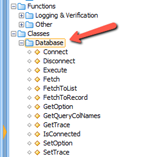
Rest and Soap
The Rest class provides a way to make Rest and Soap calls to a web server. The images below outline the available commands and provide examples of the primary actions:

File interfaces
AscentialTest provides file interfaces for CSV, INI, JSON, PDF, Text, XML files. All actions are drag & drop:
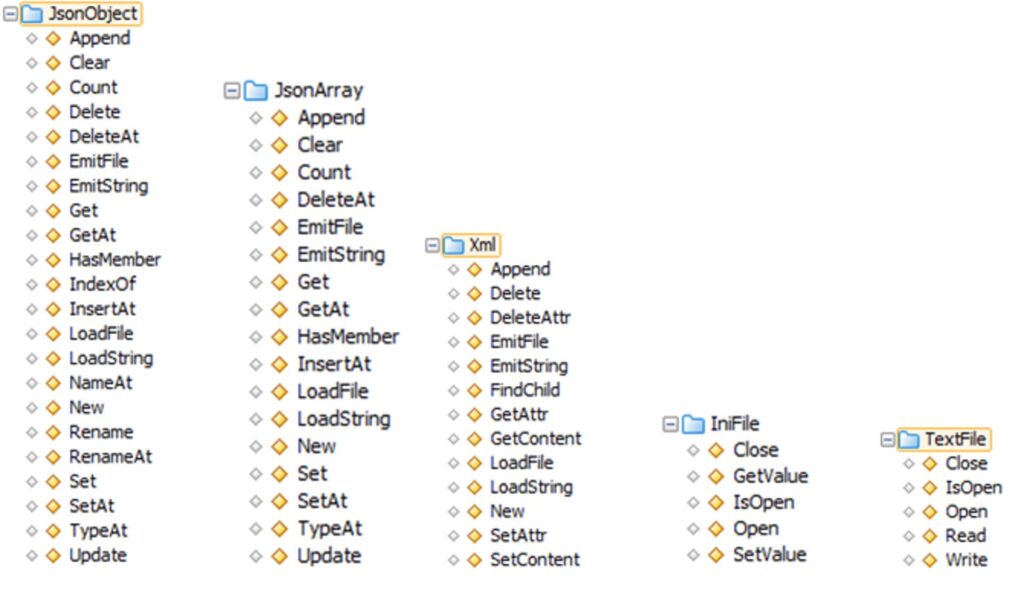
System and Windows commands
AscentialTest provides the ability to interact with the file system, make system calls and access the registry and environment variables. The images below outline the available commands and provide examples of the selected actions:
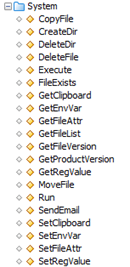
DLL
AscentialTest provides the ability to call methods published in system and application DLLs
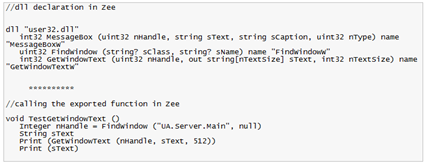
AscentialTest provides PowerBuilder automated testing support for applications from PB v6.x right up to the most current version of Appeon PowerBuilder, Power Server and Power Client including embedded Chrome and MSWebView2. The Datawindow is recognized regardless of its presentation style: Form, Grid, Group, Tabular.
PB Table Support: The image below displays a Datawindow in the form of what we call a PbTable. It has rows and columns that can contain any number of control types (checkbox, popuplist, textfield, etc.). AscentialTest provides a special feature called a ‘selector’, which makes it easy to locate a row in a table based on a target value. In the example below, the selector has located the third row in the table because it contains the test value ‘Table Management”:
PB Form Support: AscentialTest also recognizes the Datawindow in the form of what we call ‘PbForm’. Notice that the PbForm displayed below contains many different types of application objects including PbText, PbTextField, PbRadioGroup and PbCheckBox. These are only some of the control types that can be included on a form.
PB Toolbar Support: Most PowerBuilder applications include tool bars with icons that represent application tasks. AscentialTest provides special recognition for those tool bar icons to make it easy to select them:
PB Ribbon Support: Appeon recently introduced the ribbon bar as an alternative to the toolbar. As compared to the standard tool bar, the ribbon bar can contain PowerBuilder elements like Checkbox, TextField, PopupList and ComboBox:
The image below displays a Datawindow in the form of what we call a PbTable. It has rows and columns that can contain any number of control types (checkbox, popuplist, textfield, etc.). AscentialTest provides a special feature called a ‘selector’, which makes it easy to locate a row in a table based on a target value. In the example below, the selector has located the third row in the table because it contains the test value ‘Table Management”:
AscentialTest also recognizes the Datawindow in the form of what we call ‘PbForm’. Notice that the PbForm displayed below contains many different types of application objects including PbText, PbTextField, PbRadioGroup and PbCheckBox. These are only some of the control types that can be included on a form.
Most PowerBuilder applications include tool bars with icons that represent application tasks. AscentialTest provides special recognition for those tool bar icons to make it easy to select them:
Appeon recently introduced the ribbon bar as an alternative to the toolbar. As compared to the standard tool bar, the ribbon bar can contain PowerBuilder elements like Checkbox, TextField, PopupList and ComboBox:
Automated Web Testing: Unlike other testing solutions, AscentialTest does not rely on xPath to locate objects. We’ve developed a much more powerful object recognition engine that ignores the html hierarchy. As a result, objects are consistently recognized as the target application is modified over time regardless of changes to the object hierarchy or dynamically generated IDs.
AscentialTest provides built-in synchronization so that you don’t have to worry about whether the browser is in a loading or ready state, but if you want to wait for an object to appear or disappear, we’ve got that covered too with easy to use drag and drop synchronization actions.
AscentialTest also includes built-in support for unexpected popups and drag and drop validations for an array of attributes.
All tests are cross-browser. No adjustments are needed to successfully execute tests across all supported browsers. Just pick any browser, build your tests and then run them against the other browsers.
Web Table Recognition Wizard:
AscentialTest provides a table recognition wizard to help users define web tables by drag and drop.
The table, row class and all of the columns that contain the table objects are automatically defined.
Web Table Support:
AscentialTest provides a special feature called a ‘selector’, which makes it easy to locate a row in a table based on a target value. In the example to the right, the selector ‘SelectByFrom’ has located the fifth row in the table because it contains the test value ‘Seshi Reddy’
Selectors make it easy to get and set values to table objects. The ‘Test Value’ field provides a way for the user to test the selector and ensure that it has been correctly defined. Selectors are used in automated tests to set and get values from application objects. The example below shows two test actions. The first checks the ‘Msgid’ checkbox in the row that has been identified with the selector value ‘Reddy’.
The second action gets the value of the ‘Subject’ field in the row that has been identified with the selector value ‘Reddy’. Selectors make it easy to interact with objects contained in a complex object like a table or grid.
Selenium Comparison:
There is no denying that Selenium is widely used automated web testing, at least in part because it is open source. While the set of tools that comprise Selenium are free of charge, it is debated just as widely whether or not ‘free’ is really ‘free’. Consider that in any test automation project, the fee for the tool is only a small part of the overall budget when compared with the cost of building the tests. So if you pay $10,000.00 for a testing tool and $100,000.00 in labor costs, have you saved money for your organization by selecting an open source tool, when it costs many times more to build and maintain the tests?
Because Selenium is open source, supporters tend to focus on the highlights and overlook the limitations. No where will you read that Selenium is an awesome testing tool. You won’t read that it is easy to use or that the tests are easy to maintain. If there were a charge for Selenium, it is unlikely that it would be selected at all when compared to tools like AscentialTest that have been designed to promote productivity and provide a substantial return on investment in the first year of usage.
Here are some of the factors that we would like for you to consider when choosing between an open-source tool like Selenium and a for-fee tool like AscentialTest:
The second action gets the value of the ‘Subject’ field in the row that has been identified with the selector value ‘Reddy’. Selectors make it easy to interact with objects contained in a complex object like a table or grid.
AscentialTest provides DotNet automated testing for applications developed with either WinForms or WPF. All standard DotNet controls are supported including: checkbox, combobox, datagrid, expander, group, label, listbox, listview, menu, menubar, menuitem, popuplist, pushbutton, radiobutton, richtextfield, statusbar, statuspart, tab, tabgroup, text, textfield, togglebutton, toolbar, toolbutton and treeview.
Third-party controls from Component One and DevExpress are also supported. Extensions for other third-party suppliers are in the works.
In addition, an extension kit is available to add automated testing support for custom controls that have been developed by your organization.
DotNet Table Support:
AscentialTest provides unparalleled automated testing support for tables or grids developed with either WinForms or WPF including third-party controls from Component One and DevExpress.
The AscentialTest table interface allows the user to easily get, verify, select and set table elements in the target application:
The image below depicts a DotNet WPF DataGrid:
Selectors support DotNet automated testing by making it easy to get and set values to table objects. The ‘Test Value’ field provides a way for the user to test the selector and ensure that it has been correctly defined. Selectors are used in automated tests to set and get values from application objects. The example below displays a test action that uses a selector. It verifies the first name of the person that is identified with the selector value ‘Meyer’.
![]()
AscentialTest is the only testing solution that provides Omins automated testing support, available for applications built with Omnis 10 right up to the most current version.
Omnis Table Support:
The image below displays an Omins table in the form of what we call a CustomTable. It has rows and columns that can contain any number of control types (checkbox, popuplist, textfield, etc.).
AscentialTest provides a special feature called a ‘selector’, which makes it easy to locate a row in a table based on a target value. In the example below, the selector has located the third row in the table because it contains the test value ‘Arsenal’:
Omnis Elements Support:
AscentialTest Omins automated testing support is comprehensive. All Omins elements are supported including Breadcrumb, CheckBox, ComboBox, ContextMenu DropdownList, ListBox, MenuItem, PopupList, PushButton, RadioButton, TabGroup, Table/Grid, TextField, Toolbar and Treeview.
AscentialTest provides automated testing for terminal-based applications like iSeries and AS/400. Whether you’re emulating 3270 or 5250, we’ve got you covered. AscentialTest provides support for all terminal controls and command keys along with specialized object recognition for tables.
Terminal Object Recognition: All terminal control types are recognized by AscentialTest, making it easy to drive and verify terminal-based target applications.
Terminal Table Support: AscentialTest provides a table interface that allows the user to easily get, verify, select and set table elements in the target application:
AscentialTest recognizes terminal tables and provides a special feature called a ‘selector’, which makes it easy to locate a row in a table based on a target value. In the example below, the selector has located the forth row in the table because it contains the test value ‘AAA0000001’:
AscentialTest provides automated Pdf testing and verification for target application-generated documents.
The ability to verify the contents of a Pdf document may be an important part of an automated test transaction. Manual verification is time-consuming and error prone because of the amount of detail contained in the generated document. With AscentialTest, you can verify textual components within a Pdf document even if they are arranged in complex structures like tables or grids. Pdf verification is added to tests using the same drag and drop features that are used for developing automated tests against the GUI of the target application.
PDF Table Support: AscentialTest provides a special feature called a ‘selector’, which makes it easy to locate a row in a Pdf table based on a target value. In the example below, the selector has located the second row in the table because the ‘Part No’ column contains the test value ‘336003’:
Selectors make it easy to get and set values to table objects. The ‘Test Value’ field provides a way for the user to test the selector and ensure that it has been correctly defined. Selectors are used in automated pdf tests to set and get values from application objects. The example below displays a test action that uses a selector on a pdf table. It verifies the description of the part that is identified with the selector value ‘336003’.
![]()
To learn about how to insert PDF verification into your automated tests, check out this article from our blog: PDF Comparison. The article describes how AscentialTest can be used to compare an application-generated Pdf document to a baseline, masking out lines that contain variable data like date and time stamps.
AscentialTest is the only testing solution that provides Omins automated testing support, available for applications built with Omnis 10 right up to the most current version.
API Testing
In addition to the capabilities for testing and validation of the target application GUI, AscentialTest provides facilities for back-end, API testing:
ODBC
AscentialTest provides a Database class that allows the user to make SQL calls through drag and drop. The images below outline the available commands and provide examples of the primary actions:

Rest and Soap
The Rest class provides a way to make Rest and Soap calls to a web server. The images below outline the available commands and provide examples of the primary actions:

File interfaces
AscentialTest provides file interfaces for CSV, INI, JSON, PDF, Text, XML files. All actions are drag & drop:

System and Windows commands
AscentialTest provides the ability to interact with the file system, make system calls and access the registry and environment variables. The images below outline the available commands and provide examples of the selected actions:

DLL
AscentialTest provides the ability to call methods published in system and application DLLs

Includes:
Two Extensions
Additional Extensions Desired ($50 per month each)
Includes:
One Extension + Collaboration Package
Additional Extensions Desired (one extension + collaboration package already included)
Team collaboration package includes:
Includes:
One Extension + Collaboration Package
Plus annual maintenance thereafter of:
Additional Extensions Desired
Team collaboration package includes:
Included integrations:
Included collaboration features:
Plus annual maintenance thereafter of:
Included Extensions:
Included collaboration features:
Why PowerBuilder users choose AscentialTest: AscentialTest provides PowerBuilder automated testing support for applications from PB v6.x right up to the most current version of Appeon PowerBuilder. The Datawindow is recognized regardless of its presentation style: Form, Grid, Group, Tabular. The image below displays a Datawindow in the form of what we call a PbTable. It has rows and columns that can contain any number of control types (checkbox, popuplist, textfield, etc.).
The image below displays a Datawindow in the form of what we call a PbTable. It has rows and columns that can contain any number of control types (checkbox, popuplist, textfield, etc.). AscentialTest provides a special feature called a ‘selector’, which makes it easy to locate a row in a table based on a target value. In the example below, the selector has located the third row in the table because it contains the test value ‘Table Management”:
AscentialTest also recognizes the Datawindow in the form of what we call ‘PbForm’. Notice that the PbForm displayed below contains many different types of application objects including PbText, PbTextField, PbRadioGroup and PbCheckBox. These are only some of the control types that can be included on a form.
Most PowerBuilder applications include tool bars with icons that represent application tasks. AscentialTest provides special recognition for those tool bar icons to make it easy to select them:
Appeon recently introduced the ribbon bar as an alternative to the toolbar. As compared to the standard tool bar, the ribbon bar can contain PowerBuilder elements like Checkbox, TextField, PopupList and ComboBox:
The image below displays a Datawindow in the form of what we call a PbTable. It has rows and columns that can contain any number of control types (checkbox, popuplist, textfield, etc.). AscentialTest provides a special feature called a ‘selector’, which makes it easy to locate a row in a table based on a target value. In the example below, the selector has located the third row in the table because it contains the test value ‘Table Management”:
AscentialTest also recognizes the Datawindow in the form of what we call ‘PbForm’. Notice that the PbForm displayed below contains many different types of application objects including PbText, PbTextField, PbRadioGroup and PbCheckBox. These are only some of the control types that can be included on a form.
Most PowerBuilder applications include tool bars with icons that represent application tasks. AscentialTest provides special recognition for those tool bar icons to make it easy to select them:
Appeon recently introduced the ribbon bar as an alternative to the toolbar. As compared to the standard tool bar, the ribbon bar can contain PowerBuilder elements like Checkbox, TextField, PopupList and ComboBox:

Executive Summary:
Philips selected AscentialTest for test automation of PACS, a software platform for accessing a patient’s radiological history, including diagnostic reports, exam notes, clinical history and images. The test team developed a set of cross-platform tests running on both thick and thin clients, saving a significant amount of time and effort as compared with previous testing tool solutions. With AscentialTest, Philips was able to:
Client Objective:
When Vinay Krishnamurthy of Philips was tasked with developing a testing solution for PACS, he faced a number of technical challenges. The target application is deployed in three different versions to meet the needs of various types of end users. The GUI is a mixture of MFC and web controls, deployed as both thick and thin clients. These versions are then translated into 6 different languages for localized markets. Test verification requires a lot of comparison of images, along with text that is drawn upon those images to report measurements and other attributes of the scans.
Developing a separate set of test for each of the deployed versions of PACS was cost prohibitive and the organization wanted to avoid building a testing framework, which in past projects had taken 6 to 8 months to build and stabilize with existing commercial and open source tools. They were also concerned about the huge maintenance costs that they had experienced.
Furthermore, with more than 8000 tests to automate Philips wanted a scriptless solution, but had learned from experience that a record-playback tool would not provide the robustness that was required.
Our Approach:
Philips selected AscentialTest because they recognized the potential for designing a solution that could be used across platforms. Using AscentialTest’s drag and drop interface, the team uses snapshots to create object definitions that are recognized across all three platforms. They benefit from an array of options for defining objects that were difficult to recognize with other testing tools that they evaluated. Philips heavily relies on the ‘RenderText’ and ‘RenderImage’ capabilities of AscentialTest. ‘RenderText’ allows them to validate text that is drawn on scanned images. In the past, tests that require verification of that text had to be completed by manual testers. Vinay estimates that the team can automate 15% more tests because of this text recognition feature. Likewise, ‘RenderImage’ has allowed for the recognition of images for both navigation and verification of tests.
Because of the image-centric domain of PACS, Philips requires very sophisticated image ‘capture and compare’ capability. Zeenyx worked closely with Philips to enhance the existing image verification capabilities of AscentialTest. Several features were added to provide the ability to more specifically focus on the ‘area of interest’, apply masks, and tolerate for pixel and color differences.
Philips also cites AscentialTest data options as a critical component to allow the tests to be shared across platforms. By making use of ‘Project Data’, ‘Plan Data’, and ‘Attributes’, Philips is able to easily change key pieces of test configuration data in a single location to launch tests against different versions of PACS in the various test environments.
Vinay explains that the team creates two files for each page in the target application, one with the object definitions and a second with a meta-layer of steps for driving and verifying the application. Test developers use those components to build the automated tests via drag and drop.
Vinay says that the pace of automation has increased because of the reusable nature of the test components. As the more objects and steps are created, the time required to build new tests continues to decrease.
The bulk of the tests that the team has created to date are used for their ‘Smoke’ and ‘Regression’ tests runs. Recently they created a ‘Sanity’ test comprised of a handful of tests that were ‘ported’ to test six localized versions of PACS, created for different language markets. The team was surprised that it took only two days to port a test to all six languages using AscentialTest’s ‘Translate’ feature.
Results Delivered:
Philips has been able to exceed their goal of reducing the time and cost of developing automated tests by 50%. Using AscentialTest, they have reduced the average time to build an automated test scenario from 6 to 2 ½ to 3 ½ days. They have also been able to cut execution time in half. The automation team has integrated AscentialTest with TFS to launch tests and have taken advantage of a recent AscentialTest feature where ‘failed’ tests can be easily selected and rerun without user intervention.
Philips credits the support that they received from both Zeenyx and MatryxSoft, their local distributor, for their success with AscentialTest. We are happy to have exceeded their expectations for response time for fixes and enhancement requests.

Executive Summary:
Autodesk selected AscentialTest for test automation of Dynamo Studio and developed a set of cross- platform tests running on both the Web and WPF clients targeted at identifying resource allocation issues in a complex multi-tiered application stack. They successfully found and fixed serious back-end issues by driving thousands of workflows through application engines and analyzing allocation of memory and other system resources to ensure that the system could handle the expected load. With AscentialTest, Autodesk was able to:
Client Objective:
When Neal Burnham of Autodesk was tasked with developing a testing solution for Dynamo Studio, he faced both organizational and technical challenges. There was a mindset in place to use open-source tools and to test at the unit level using harnesses embedded in the code itself, but the harness that he inherited did not run reliably. His intuition told him that the most efficient way to identify issues with the backend was to test through the application’s GUI using a commercial testing tool.
Before selecting AscentialTest, Neal looked at open-source alternatives including AutoIt, Selenium and Winium, but he knew from experience that given the complexity of what had to be validated, something much more powerful was required. Any of these solutions could have been used to drive use cases through the GUI, but the target was a validation of the underlying engine that converts graphical programs into other formats. This is where the rubber hits the road. To validate a multi-tiered application, Neal needed to be able to analyze XML, data accessed from the Chrome dashboard and resource allocation metrics from the OS. He also needed to verify that all file contents were correct, and that the graphics were correctly rendered.
The Dynamo GUI is available in two versions. Users can access Dynamo through either a WPF desktop application or through the Chrome browser. To reduce the level of effort to build and maintain tests, Neal wanted to create a meta layer where he could drive real world workflows through both versions of the application.
Our Approach:
Neal selected AscentialTest because he recognized the potential for designing a class of solutions to solve a class of problems. He understood the power of building small, reusable components that could be glued together and scaled up to form a broad solution.
Using AscentialTest’s snapshots, he built a matching set of object definitions to normalize the thick and thin client user interfaces. This layer allowed all of the test components to be shared across platforms. Instead of having to build separate tests for the WPF and Web versions of the Dynamo GUI, he cut his work in half by building one set that could reference either object repository.
Neal also built a validation mechanism to ensure the integrity of numerous complex file conversions. His approach involved parsing data from the Chrome developer console and XML files stored in the file system and comparing sets of data to expected results. He also used AscentialTest image capture and compare features to ensure that graphics were rendered properly.
The ability to have deployed agents on various target machines was also an important component of the solution. Neal needed to ensure that he could drive the GUI hard and fast from multiple client machines in an industrial fashion, sending thousands of workflows through the engines to confirm proper allocation of memory and other system resources necessary for the system to hold up over time.
Because Neal’s solution is not embedded in the application code, he can continue to run the regression tests without being impacted by change as the back-end technologies continue to evolve or be replaced. He believes that one of the strengths of a productized offering like AscentialTest is that he is assured that his test assets are permanent. He cites a recent announcement that the Selenium ‘Keys’ command will be deprecated soon, making it necessary to modify tests to keep them running. Because AscentialTest is a complete solution, there is no need to search for plug-ins and apply workarounds. The Zee testing language is fully formed, and aspects of the product will not be deprecated in the future.
Results Delivered:
Over the course of four months, the set of tests that Neal built with AscentialTest were used to improve the stability and performance of Dynamo Studio. Initially the system failed after only an hour of execution. The tests needed to be bullet-proofed and retry loops were added because it was important to be able to keep the tests running even as the system began to fail. At first small incremental improvements were made. Eventually an incorrect memory setting was found in AWS. It had manifested in a way that the regression caught, but it was difficult to find and fix. Resolving that problem was a big win not only for Dynamo Studio. It also highlighted how process improvement can be made by breaking out of a culture of open source that had almost become religion. Using an alternative approach proved that testing from the front end with a commercial solution can yield benefits that were not obtainable using the strategy that had been become common practice. The fix in this case was not small potatoes. Neal estimates that it was worth hundreds of thousands of dollars to the bottom line.
The Dynamo team also found that AscentialTest brought immediate value in an unexpected way when a Mongo database was hacked, and all of the test data lost. Fortunately, Neal had built ‘tests’ that were capable of restoring data. He said that capability “really got people’s attention” and even naysayers were stunned when it came to the rescue a second time several months later.
Being able to start building tests immediately without having to spend a lot of time building a test harness is something Neal appreciates about AscentialTest. He found that he can whip something up that can be used to identify a memory leak in a half hour. He considers it a huge win for development to be able to build tests that have a limited shelf life because the level of effort is so small. That works well in an Agile, CI environment where the feedback cycle is short.
When compared to an open-source solution, Neal found that AscentialTest is not limited. When the inevitable stumbling blocks occur, there is a dedicated technical support staff to call on along with a user forum in the Zeenyx eco system that is very targeted. While there is a huge base of Selenium users, the available help is un-curated. Neal says that in that environment “you have to do all the work, whereas with AscentialTest, there’s one place to go for an answer”.

Executive Summary:
Starchive, a client of Loop Software Services and Testing, recently selected AscentialTest for its web-based application testing. Starchive made the switch for a variety of reasons and through AscentialTest, Loop was able to provide Starchive with the ability to:
Client Objective:
When Starchive first made the switch from manual to automated testing, it was not without challenges, both general and technical. When it came to the performance data of their application, there was no historical data. At that point in time it was not cost-effective to gather data on Starchive’s application performance, therefore it was not always known how a new feature or change affected the application performance. When creating new features and changes in the backend, regressions were run to ensure the changes did not create any breakage, but other than apparent positive or negative performance changes, no performance metrics could be easily tracked.
Another challenge that arose was related to Starchive’s React Framework architecture which creates code generated classes for delivering asynchronous experiences. This caused the application’s object ID’s to be dynamic, making open-source automation testing solutions extremely difficult to maintain. Automated tests consistently broke, leaving Starchive concerned about their automated product testing and the costs to maintain it.
Creation and maintenance of the regression suites presented a unique challenge, as Starchive’s highly effective development team was able to rapidly create new features and backend updates. The application’s mission, storing massive file sets and handling extremely large uploads/downloads has led to issues with verification of uploads/downloads during testing, with the manual approach unable to verify such massive file sets in a cost effective manner.
Our Approach:
Starchive chose to implement AscentialTest based on the recommendation of Matt Osiecki, Head of Automation at LSTS as he saw the large benefits that Starchive would see by choosing this solution. Because of his recommendation, Starchive began utilizing AscentialTest. The initial automation build was focused on performance testing.
AscentialTest is now used to track performance times when uploading, downloading, as well as general page load times within Starchive’s application. The tests are run daily which document performance times in a client facing dashboard and the results are compared to daily, weekly, and monthly results. Any test results that are abnormal are automatically reported to the client within an “Automation” Slack channel. The performance tests are now able to run after any change in the application on both frontend and backend which allows Starchive to see the immediate performance impact of changes.
Another position in which AscentialTest is bolstering Starchive is in its ability to identify objects based on innumerable attributes such as color, position, webtext, parent objects, and others. Dynamic IDs which would normally break open sourced framework automation can be defensively defined within AscentialTest, giving it the definite advantage.
The ability for rapid development was another significant advantage of using AscentialTest. The test case creation and maintenance within AscentialTest proved to be much more efficient than when compared to manual or traditional automated frameworks.
Regarding maintenance, the tests built in AscentialTest are composed of steps and even sub-steps. These building blocks are then used across a variety of different tests. When a change occurs on the frontend, the step that is impacted can be updated, which updates all references and tests containing the step. Because Starchive consistently rolls out new features, a feature change that affects 1000+ test cases would take days to update within a manual suite, but can be done in minutes with AscentialTest’s prowess.
With reference to the creation side of things, Step, the building blocks of tests, can be reused within a test or across multiple tests. Once the steps are created within AscentialTest, it is a simple process to drag and drop them into a new test, instead of building an entire new test from scratch. This means that reusing previously created steps can significantly reduce the hours spent on test creation.
Starchive also shows huge improvements in the verification process via AscentialTest. Before, verifying upload/download/management of thousands of files would be cost-prohibitive and nearly impossible, with the likelihood of human error if done manually. Now, a verification step can be created to verify a file’s image, title, created by date, along with 30+ other properties. This step can be rerun on every file uploaded/download/edited, verifying each file in seconds, while not consuming person hours.
Results Delivered:
The effects of AscentialTest were seen straight away. There was immediate validation of new features and backend change impact on performance which was directly reported to the Starchive team within Slack. Improved user experience and adoption also rose and performance pain points are now able to be identified (slow uploading time, long page load time) via automation and remedied quickly by the development team.
When compared to open-source solutions, AscentialTest’s automation suite proved that it is resilient to dynamic ID changes, saving time and money on maintenance. Less maintenance also means that Starchive is able to obtain the test results more quickly.
The Starchive team and Loop found that the regression suite can be built and maintained much faster when compared to manual testing, saving Starchive considerable monetary investment. The automated suite is faster than manual regressions, completes more test cases with each of them covering more scenarios.
The file set verification system ensures Starchive that any files set, file type, file set size, can be uploaded, edited, and downloaded within Starchive while retaining all original data. Any issues found during file set verification can be remedied before the push to production. AscentialTest has saved Starchive time and money while opening up new testing possibilities.

Executive Summary:
The Nutrition Coordinating Center at the University of Minnesota selected AscentialTest for test automation of its Nutrition Data System for Research application and developed over a thousand automated tests which:
Client Objective:
Gordon Weil of the Nutrition Coordinating Center found that testing NDSR manually is time-consuming. It takes 2 to 3 person weeks to run a regression test on one version of windows, but since they support multiple versions at any given time, it just isn’t feasible, especially given that the organization doesn’t have a dedicated testing staff. Gordon found that there weren’t people available to execute the tests when he needed them.
He began investigating automated testing solutions. He tried a few open source and commercial tools, but none of them worked well with PowerBuilder, upon which NDSR is built. He also needed to find a solution that was easy to learn since he planned to use students to build the automated tests.
Our Approach:
Gordon selected AscentialTest both because it provides support for PowerBuilder and because it’s easy to learn and use. Students were hired to convert their well-documented manual tests into automated tests. Gordon said that he spent only an hour or two training the students to use AscentialTest. Over the course of a summer, two students automated 1075 tests. The regression suite comprises a comprehensive set of tests that cover all aspects of the NDSR application. When the project started, NDSR was built with PowerBuilder 12.5, but was recently converted to PB 2017. Tests are separated into different plans by functional area. One plan, which runs for a couple of hours, generates a thousand reports which are compared to baselines that have been previously captured. Reports contain a large number of calculations that need to be validated. AscentialTest is used to find any differences that are later examined.
Results Delivered:
The test cycle for the original set of tests was reduced from 2 to 3 person weeks to 1 to 2 days. Additional tests have since been added to increase coverage. The regression is primarily used to ensure that when changes are made, nothing is broken. It occasionally uncovers a problem, but even when it doesn’t identify an issue, it provides confidence to the organization that the application is going to perform well for its customers. Prior to using AscentialTest, adding a new report to the system was costly because validation requires a huge amount of labor and time. Some of the tests would need to be executed by a trained nutritionist, whose time is very valuable to the organization. Gordon estimates that $10,000.00 is saved every time a regression needs to be executed and the feedback loop is significantly shorter. He no longer has to wait the 2 to 3 weeks that it would take to run the same tests manually.

Executive Summary:
Starchive, a client of Loop Software Services and Testing, recently selected AscentialTest for its web-based application testing. Starchive made the switch for a variety of reasons and through AscentialTest, Loop was able to provide Starchive with the ability to:
Client Objective:
When Starchive first made the switch from manual to automated testing, it was not without challenges, both general and technical. When it came to the performance data of their application, there was no historical data. At that point in time it was not cost-effective to gather data on Starchive’s application performance, therefore it was not always known how a new feature or change affected the application performance. When creating new features and changes in the backend, regressions were run to ensure the changes did not create any breakage, but other than apparent positive or negative performance changes, no performance metrics could be easily tracked.
Another challenge that arose was related to Starchive’s React Framework architecture which creates code generated classes for delivering asynchronous experiences. This caused the application’s object ID’s to be dynamic, making open-source automation testing solutions extremely difficult to maintain. Automated tests consistently broke, leaving Starchive concerned about their automated product testing and the costs to maintain it.
Creation and maintenance of the regression suites presented a unique challenge, as Starchive’s highly effective development team was able to rapidly create new features and backend updates. The application’s mission, storing massive file sets and handling extremely large uploads/downloads has led to issues with verification of uploads/downloads during testing, with the manual approach unable to verify such massive file sets in a cost effective manner.
Our Approach:
Starchive chose to implement AscentialTest based on the recommendation of Matt Osiecki, Head of Automation at LSTS as he saw the large benefits that Starchive would see by choosing this solution. Because of his recommendation, Starchive began utilizing AscentialTest. The initial automation build was focused on performance testing.
AscentialTest is now used to track performance times when uploading, downloading, as well as general page load times within Starchive’s application. The tests are run daily which document performance times in a client facing dashboard and the results are compared to daily, weekly, and monthly results. Any test results that are abnormal are automatically reported to the client within an “Automation” Slack channel. The performance tests are now able to run after any change in the application on both frontend and backend which allows Starchive to see the immediate performance impact of changes.
Another position in which AscentialTest is bolstering Starchive is in its ability to identify objects based on innumerable attributes such as color, position, webtext, parent objects, and others. Dynamic IDs which would normally break open sourced framework automation can be defensively defined within AscentialTest, giving it the definite advantage.
The ability for rapid development was another significant advantage of using AscentialTest. The test case creation and maintenance within AscentialTest proved to be much more efficient than when compared to manual or traditional automated frameworks.
Regarding maintenance, the tests built in AscentialTest are composed of steps and even sub-steps. These building blocks are then used across a variety of different tests. When a change occurs on the frontend, the step that is impacted can be updated, which updates all references and tests containing the step. Because Starchive consistently rolls out new features, a feature change that affects 1000+ test cases would take days to update within a manual suite, but can be done in minutes with AscentialTest’s prowess.
With reference to the creation side of things, Step, the building blocks of tests, can be reused within a test or across multiple tests. Once the steps are created within AscentialTest, it is a simple process to drag and drop them into a new test, instead of building an entire new test from scratch. This means that reusing previously created steps can significantly reduce the hours spent on test creation.
Starchive also shows huge improvements in the verification process via AscentialTest. Before, verifying upload/download/management of thousands of files would be cost-prohibitive and nearly impossible, with the likelihood of human error if done manually. Now, a verification step can be created to verify a file’s image, title, created by date, along with 30+ other properties. This step can be rerun on every file uploaded/download/edited, verifying each file in seconds, while not consuming person hours.
Results Delivered:
The effects of AscentialTest were seen straight away. There was immediate validation of new features and backend change impact on performance which was directly reported to the Starchive team within Slack. Improved user experience and adoption also rose and performance pain points are now able to be identified (slow uploading time, long page load time) via automation and remedied quickly by the development team.
When compared to open-source solutions, AscentialTest’s automation suite proved that it is resilient to dynamic ID changes, saving time and money on maintenance. Less maintenance also means that Starchive is able to obtain the test results more quickly.
The Starchive team and Loop found that the regression suite can be built and maintained much faster when compared to manual testing, saving Starchive considerable monetary investment. The automated suite is faster than manual regressions, completes more test cases with each of them covering more scenarios.
The file set verification system ensures Starchive that any files set, file type, file set size, can be uploaded, edited, and downloaded within Starchive while retaining all original data. Any issues found during file set verification can be remedied before the push to production. AscentialTest has saved Starchive time and money while opening up new testing possibilities.

Executive Summary:
Philips selected AscentialTest for test automation of PACS, a software platform for accessing a patient’s radiological history, including diagnostic reports, exam notes, clinical history and images. The test team developed a set of cross-platform tests running on both thick and thin clients, saving a significant amount of time and effort as compared with previous testing tool solutions. With AscentialTest, Philips was able to:
Client Objective:
When Vinay Krishnamurthy of Philips was tasked with developing a testing solution for PACS, he faced a number of technical challenges. The target application is deployed in three different versions to meet the needs of various types of end users. The GUI is a mixture of MFC and web controls, deployed as both thick and thin clients. These versions are then translated into 6 different languages for localized markets. Test verification requires a lot of comparison of images, along with text that is drawn upon those images to report measurements and other attributes of the scans.
Developing a separate set of test for each of the deployed versions of PACS was cost prohibitive and the organization wanted to avoid building a testing framework, which in past projects had taken 6 to 8 months to build and stabilize with existing commercial and open source tools. They were also concerned about the huge maintenance costs that they had experienced.
Furthermore, with more than 8000 tests to automate Philips wanted a scriptless solution, but had learned from experience that a record-playback tool would not provide the robustness that was required.
Our Approach:
Philips selected AscentialTest because they recognized the potential for designing a solution that could be used across platforms. Using AscentialTest’s drag and drop interface, the team uses snapshots to create object definitions that are recognized across all three platforms. They benefit from an array of options for defining objects that were difficult to recognize with other testing tools that they evaluated. Philips heavily relies on the ‘RenderText’ and ‘RenderImage’ capabilities of AscentialTest. ‘RenderText’ allows them to validate text that is drawn on scanned images. In the past, tests that require verification of that text had to be completed by manual testers. Vinay estimates that the team can automate 15% more tests because of this text recognition feature. Likewise, ‘RenderImage’ has allowed for the recognition of images for both navigation and verification of tests.
Because of the image-centric domain of PACS, Philips requires very sophisticated image ‘capture and compare’ capability. Zeenyx worked closely with Philips to enhance the existing image verification capabilities of AscentialTest. Several features were added to provide the ability to more specifically focus on the ‘area of interest’, apply masks, and tolerate for pixel and color differences.
Philips also cites AscentialTest data options as a critical component to allow the tests to be shared across platforms. By making use of ‘Project Data’, ‘Plan Data’, and ‘Attributes’, Philips is able to easily change key pieces of test configuration data in a single location to launch tests against different versions of PACS in the various test environments.
Vinay explains that the team creates two files for each page in the target application, one with the object definitions and a second with a meta-layer of steps for driving and verifying the application. Test developers use those components to build the automated tests via drag and drop.
Vinay says that the pace of automation has increased because of the reusable nature of the test components. As the more objects and steps are created, the time required to build new tests continues to decrease.
The bulk of the tests that the team has created to date are used for their ‘Smoke’ and ‘Regression’ tests runs. Recently they created a ‘Sanity’ test comprised of a handful of tests that were ‘ported’ to test six localized versions of PACS, created for different language markets. The team was surprised that it took only two days to port a test to all six languages using AscentialTest’s ‘Translate’ feature.
Results Delivered:
Philips has been able to exceed their goal of reducing the time and cost of developing automated tests by 50%. Using AscentialTest, they have reduced the average time to build an automated test scenario from 6 to 2 ½ to 3 ½ days. They have also been able to cut execution time in half. The automation team has integrated AscentialTest with TFS to launch tests and have taken advantage of a recent AscentialTest feature where ‘failed’ tests can be easily selected and rerun without user intervention.
Philips credits the support that they received from both Zeenyx and MatryxSoft, their local distributor, for their success with AscentialTest. We are happy to have exceeded their expectations for response time for fixes and enhancement requests.

Executive Summary:
The Nutrition Coordinating Center at the University of Minnesota selected AscentialTest for test automation of its Nutrition Data System for Research application and developed over a thousand automated tests which:
Client Objective:
Gordon Weil of the Nutrition Coordinating Center found that testing NDSR manually is time-consuming. It takes 2 to 3 person weeks to run a regression test on one version of windows, but since they support multiple versions at any given time, it just isn’t feasible, especially given that the organization doesn’t have a dedicated testing staff. Gordon found that there weren’t people available to execute the tests when he needed them.
He began investigating automated testing solutions. He tried a few open source and commercial tools, but none of them worked well with PowerBuilder, upon which NDSR is built. He also needed to find a solution that was easy to learn since he planned to use students to build the automated tests.
Our Approach:
Gordon selected AscentialTest both because it provides support for PowerBuilder and because it’s easy to learn and use. Students were hired to convert their well-documented manual tests into automated tests. Gordon said that he spent only an hour or two training the students to use AscentialTest. Over the course of a summer, two students automated 1075 tests. The regression suite comprises a comprehensive set of tests that cover all aspects of the NDSR application. When the project started, NDSR was built with PowerBuilder 12.5, but was recently converted to PB 2017. Tests are separated into different plans by functional area. One plan, which runs for a couple of hours, generates a thousand reports which are compared to baselines that have been previously captured. Reports contain a large number of calculations that need to be validated. AscentialTest is used to find any differences that are later examined.
Results Delivered:
The test cycle for the original set of tests was reduced from 2 to 3 person weeks to 1 to 2 days. Additional tests have since been added to increase coverage. The regression is primarily used to ensure that when changes are made, nothing is broken. It occasionally uncovers a problem, but even when it doesn’t identify an issue, it provides confidence to the organization that the application is going to perform well for its customers. Prior to using AscentialTest, adding a new report to the system was costly because validation requires a huge amount of labor and time. Some of the tests would need to be executed by a trained nutritionist, whose time is very valuable to the organization. Gordon estimates that $10,000.00 is saved every time a regression needs to be executed and the feedback loop is significantly shorter. He no longer has to wait the 2 to 3 weeks that it would take to run the same tests manually.

Executive Summary:
Autodesk selected AscentialTest for test automation of Dynamo Studio and developed a set of cross- platform tests running on both the Web and WPF clients targeted at identifying resource allocation issues in a complex multi-tiered application stack. They successfully found and fixed serious back-end issues by driving thousands of workflows through application engines and analyzing allocation of memory and other system resources to ensure that the system could handle the expected load. With AscentialTest, Autodesk was able to:
Client Objective:
When Neal Burnham of Autodesk was tasked with developing a testing solution for Dynamo Studio, he faced both organizational and technical challenges. There was a mindset in place to use open-source tools and to test at the unit level using harnesses embedded in the code itself, but the harness that he inherited did not run reliably. His intuition told him that the most efficient way to identify issues with the backend was to test through the application’s GUI using a commercial testing tool.
Before selecting AscentialTest, Neal looked at open-source alternatives including AutoIt, Selenium and Winium, but he knew from experience that given the complexity of what had to be validated, something much more powerful was required. Any of these solutions could have been used to drive use cases through the GUI, but the target was a validation of the underlying engine that converts graphical programs into other formats. This is where the rubber hits the road. To validate a multi-tiered application, Neal needed to be able to analyze XML, data accessed from the Chrome dashboard and resource allocation metrics from the OS. He also needed to verify that all file contents were correct, and that the graphics were correctly rendered.
The Dynamo GUI is available in two versions. Users can access Dynamo through either a WPF desktop application or through the Chrome browser. To reduce the level of effort to build and maintain tests, Neal wanted to create a meta layer where he could drive real world workflows through both versions of the application.
Our Approach:
Neal selected AscentialTest because he recognized the potential for designing a class of solutions to solve a class of problems. He understood the power of building small, reusable components that could be glued together and scaled up to form a broad solution.
Using AscentialTest’s snapshots, he built a matching set of object definitions to normalize the thick and thin client user interfaces. This layer allowed all of the test components to be shared across platforms. Instead of having to build separate tests for the WPF and Web versions of the Dynamo GUI, he cut his work in half by building one set that could reference either object repository.
Neal also built a validation mechanism to ensure the integrity of numerous complex file conversions. His approach involved parsing data from the Chrome developer console and XML files stored in the file system and comparing sets of data to expected results. He also used AscentialTest image capture and compare features to ensure that graphics were rendered properly.
The ability to have deployed agents on various target machines was also an important component of the solution. Neal needed to ensure that he could drive the GUI hard and fast from multiple client machines in an industrial fashion, sending thousands of workflows through the engines to confirm proper allocation of memory and other system resources necessary for the system to hold up over time.
Because Neal’s solution is not embedded in the application code, he can continue to run the regression tests without being impacted by change as the back-end technologies continue to evolve or be replaced. He believes that one of the strengths of a productized offering like AscentialTest is that he is assured that his test assets are permanent. He cites a recent announcement that the Selenium ‘Keys’ command will be deprecated soon, making it necessary to modify tests to keep them running. Because AscentialTest is a complete solution, there is no need to search for plug-ins and apply workarounds. The Zee testing language is fully formed, and aspects of the product will not be deprecated in the future.
Results Delivered:
Over the course of four months, the set of tests that Neal built with AscentialTest were used to improve the stability and performance of Dynamo Studio. Initially the system failed after only an hour of execution. The tests needed to be bullet-proofed and retry loops were added because it was important to be able to keep the tests running even as the system began to fail. At first small incremental improvements were made. Eventually an incorrect memory setting was found in AWS. It had manifested in a way that the regression caught, but it was difficult to find and fix. Resolving that problem was a big win not only for Dynamo Studio. It also highlighted how process improvement can be made by breaking out of a culture of open source that had almost become religion. Using an alternative approach proved that testing from the front end with a commercial solution can yield benefits that were not obtainable using the strategy that had been become common practice. The fix in this case was not small potatoes. Neal estimates that it was worth hundreds of thousands of dollars to the bottom line.
The Dynamo team also found that AscentialTest brought immediate value in an unexpected way when a Mongo database was hacked, and all of the test data lost. Fortunately, Neal had built ‘tests’ that were capable of restoring data. He said that capability “really got people’s attention” and even naysayers were stunned when it came to the rescue a second time several months later.
Being able to start building tests immediately without having to spend a lot of time building a test harness is something Neal appreciates about AscentialTest. He found that he can whip something up that can be used to identify a memory leak in a half hour. He considers it a huge win for development to be able to build tests that have a limited shelf life because the level of effort is so small. That works well in an Agile, CI environment where the feedback cycle is short.
When compared to an open-source solution, Neal found that AscentialTest is not limited. When the inevitable stumbling blocks occur, there is a dedicated technical support staff to call on along with a user forum in the Zeenyx eco system that is very targeted. While there is a huge base of Selenium users, the available help is un-curated. Neal says that in that environment “you have to do all the work, whereas with AscentialTest, there’s one place to go for an answer”.

Executive Summary:
Starchive, a client of Loop Software Services and Testing, recently selected AscentialTest for its web-based application testing. Starchive made the switch for a variety of reasons and through AscentialTest, Loop was able to provide Starchive with the ability to:
Client Objective:
When Starchive first made the switch from manual to automated testing, it was not without challenges, both general and technical. When it came to the performance data of their application, there was no historical data. At that point in time it was not cost-effective to gather data on Starchive’s application performance, therefore it was not always known how a new feature or change affected the application performance. When creating new features and changes in the backend, regressions were run to ensure the changes did not create any breakage, but other than apparent positive or negative performance changes, no performance metrics could be easily tracked.
Another challenge that arose was related to Starchive’s React Framework architecture which creates code generated classes for delivering asynchronous experiences. This caused the application’s object ID’s to be dynamic, making open-source automation testing solutions extremely difficult to maintain. Automated tests consistently broke, leaving Starchive concerned about their automated product testing and the costs to maintain it.
Creation and maintenance of the regression suites presented a unique challenge, as Starchive’s highly effective development team was able to rapidly create new features and backend updates. The application’s mission, storing massive file sets and handling extremely large uploads/downloads has led to issues with verification of uploads/downloads during testing, with the manual approach unable to verify such massive file sets in a cost effective manner.
Our Approach:
Starchive chose to implement AscentialTest based on the recommendation of Matt Osiecki, Head of Automation at LSTS as he saw the large benefits that Starchive would see by choosing this solution. Because of his recommendation, Starchive began utilizing AscentialTest. The initial automation build was focused on performance testing.
AscentialTest is now used to track performance times when uploading, downloading, as well as general page load times within Starchive’s application. The tests are run daily which document performance times in a client facing dashboard and the results are compared to daily, weekly, and monthly results. Any test results that are abnormal are automatically reported to the client within an “Automation” Slack channel. The performance tests are now able to run after any change in the application on both frontend and backend which allows Starchive to see the immediate performance impact of changes.
Another position in which AscentialTest is bolstering Starchive is in its ability to identify objects based on innumerable attributes such as color, position, webtext, parent objects, and others. Dynamic IDs which would normally break open sourced framework automation can be defensively defined within AscentialTest, giving it the definite advantage.
The ability for rapid development was another significant advantage of using AscentialTest. The test case creation and maintenance within AscentialTest proved to be much more efficient than when compared to manual or traditional automated frameworks.
Regarding maintenance, the tests built in AscentialTest are composed of steps and even sub-steps. These building blocks are then used across a variety of different tests. When a change occurs on the frontend, the step that is impacted can be updated, which updates all references and tests containing the step. Because Starchive consistently rolls out new features, a feature change that affects 1000+ test cases would take days to update within a manual suite, but can be done in minutes with AscentialTest’s prowess.
With reference to the creation side of things, Step, the building blocks of tests, can be reused within a test or across multiple tests. Once the steps are created within AscentialTest, it is a simple process to drag and drop them into a new test, instead of building an entire new test from scratch. This means that reusing previously created steps can significantly reduce the hours spent on test creation.
Starchive also shows huge improvements in the verification process via AscentialTest. Before, verifying upload/download/management of thousands of files would be cost-prohibitive and nearly impossible, with the likelihood of human error if done manually. Now, a verification step can be created to verify a file’s image, title, created by date, along with 30+ other properties. This step can be rerun on every file uploaded/download/edited, verifying each file in seconds, while not consuming person hours.
Results Delivered:
The effects of AscentialTest were seen straight away. There was immediate validation of new features and backend change impact on performance which was directly reported to the Starchive team within Slack. Improved user experience and adoption also rose and performance pain points are now able to be identified (slow uploading time, long page load time) via automation and remedied quickly by the development team.
When compared to open-source solutions, AscentialTest’s automation suite proved that it is resilient to dynamic ID changes, saving time and money on maintenance. Less maintenance also means that Starchive is able to obtain the test results more quickly.
The Starchive team and Loop found that the regression suite can be built and maintained much faster when compared to manual testing, saving Starchive considerable monetary investment. The automated suite is faster than manual regressions, completes more test cases with each of them covering more scenarios.
The file set verification system ensures Starchive that any files set, file type, file set size, can be uploaded, edited, and downloaded within Starchive while retaining all original data. Any issues found during file set verification can be remedied before the push to production. AscentialTest has saved Starchive time and money while opening up new testing possibilities.

Executive Summary:
Philips selected AscentialTest for test automation of PACS, a software platform for accessing a patient’s radiological history, including diagnostic reports, exam notes, clinical history and images. The test team developed a set of cross-platform tests running on both thick and thin clients, saving a significant amount of time and effort as compared with previous testing tool solutions. With AscentialTest, Philips was able to:
Client Objective:
When Vinay Krishnamurthy of Philips was tasked with developing a testing solution for PACS, he faced a number of technical challenges. The target application is deployed in three different versions to meet the needs of various types of end users. The GUI is a mixture of MFC and web controls, deployed as both thick and thin clients. These versions are then translated into 6 different languages for localized markets. Test verification requires a lot of comparison of images, along with text that is drawn upon those images to report measurements and other attributes of the scans.
Developing a separate set of test for each of the deployed versions of PACS was cost prohibitive and the organization wanted to avoid building a testing framework, which in past projects had taken 6 to 8 months to build and stabilize with existing commercial and open source tools. They were also concerned about the huge maintenance costs that they had experienced.
Furthermore, with more than 8000 tests to automate Philips wanted a scriptless solution, but had learned from experience that a record-playback tool would not provide the robustness that was required.
Our Approach:
Philips selected AscentialTest because they recognized the potential for designing a solution that could be used across platforms. Using AscentialTest’s drag and drop interface, the team uses snapshots to create object definitions that are recognized across all three platforms. They benefit from an array of options for defining objects that were difficult to recognize with other testing tools that they evaluated. Philips heavily relies on the ‘RenderText’ and ‘RenderImage’ capabilities of AscentialTest. ‘RenderText’ allows them to validate text that is drawn on scanned images. In the past, tests that require verification of that text had to be completed by manual testers. Vinay estimates that the team can automate 15% more tests because of this text recognition feature. Likewise, ‘RenderImage’ has allowed for the recognition of images for both navigation and verification of tests.
Because of the image-centric domain of PACS, Philips requires very sophisticated image ‘capture and compare’ capability. Zeenyx worked closely with Philips to enhance the existing image verification capabilities of AscentialTest. Several features were added to provide the ability to more specifically focus on the ‘area of interest’, apply masks, and tolerate for pixel and color differences.
Philips also cites AscentialTest data options as a critical component to allow the tests to be shared across platforms. By making use of ‘Project Data’, ‘Plan Data’, and ‘Attributes’, Philips is able to easily change key pieces of test configuration data in a single location to launch tests against different versions of PACS in the various test environments.
Vinay explains that the team creates two files for each page in the target application, one with the object definitions and a second with a meta-layer of steps for driving and verifying the application. Test developers use those components to build the automated tests via drag and drop.
Vinay says that the pace of automation has increased because of the reusable nature of the test components. As the more objects and steps are created, the time required to build new tests continues to decrease.
The bulk of the tests that the team has created to date are used for their ‘Smoke’ and ‘Regression’ tests runs. Recently they created a ‘Sanity’ test comprised of a handful of tests that were ‘ported’ to test six localized versions of PACS, created for different language markets. The team was surprised that it took only two days to port a test to all six languages using AscentialTest’s ‘Translate’ feature.
Results Delivered:
Philips has been able to exceed their goal of reducing the time and cost of developing automated tests by 50%. Using AscentialTest, they have reduced the average time to build an automated test scenario from 6 to 2 ½ to 3 ½ days. They have also been able to cut execution time in half. The automation team has integrated AscentialTest with TFS to launch tests and have taken advantage of a recent AscentialTest feature where ‘failed’ tests can be easily selected and rerun without user intervention.
Philips credits the support that they received from both Zeenyx and MatryxSoft, their local distributor, for their success with AscentialTest. We are happy to have exceeded their expectations for response time for fixes and enhancement requests.

Executive Summary:
The Nutrition Coordinating Center at the University of Minnesota selected AscentialTest for test automation of its Nutrition Data System for Research application and developed over a thousand automated tests which:
Client Objective:
Gordon Weil of the Nutrition Coordinating Center found that testing NDSR manually is time-consuming. It takes 2 to 3 person weeks to run a regression test on one version of windows, but since they support multiple versions at any given time, it just isn’t feasible, especially given that the organization doesn’t have a dedicated testing staff. Gordon found that there weren’t people available to execute the tests when he needed them.
He began investigating automated testing solutions. He tried a few open source and commercial tools, but none of them worked well with PowerBuilder, upon which NDSR is built. He also needed to find a solution that was easy to learn since he planned to use students to build the automated tests.
Our Approach:
Gordon selected AscentialTest both because it provides support for PowerBuilder and because it’s easy to learn and use. Students were hired to convert their well-documented manual tests into automated tests. Gordon said that he spent only an hour or two training the students to use AscentialTest. Over the course of a summer, two students automated 1075 tests. The regression suite comprises a comprehensive set of tests that cover all aspects of the NDSR application. When the project started, NDSR was built with PowerBuilder 12.5, but was recently converted to PB 2017. Tests are separated into different plans by functional area. One plan, which runs for a couple of hours, generates a thousand reports which are compared to baselines that have been previously captured. Reports contain a large number of calculations that need to be validated. AscentialTest is used to find any differences that are later examined.
Results Delivered:
The test cycle for the original set of tests was reduced from 2 to 3 person weeks to 1 to 2 days. Additional tests have since been added to increase coverage. The regression is primarily used to ensure that when changes are made, nothing is broken. It occasionally uncovers a problem, but even when it doesn’t identify an issue, it provides confidence to the organization that the application is going to perform well for its customers. Prior to using AscentialTest, adding a new report to the system was costly because validation requires a huge amount of labor and time. Some of the tests would need to be executed by a trained nutritionist, whose time is very valuable to the organization. Gordon estimates that $10,000.00 is saved every time a regression needs to be executed and the feedback loop is significantly shorter. He no longer has to wait the 2 to 3 weeks that it would take to run the same tests manually.

Executive Summary:
Autodesk selected AscentialTest for test automation of Dynamo Studio and developed a set of cross- platform tests running on both the Web and WPF clients targeted at identifying resource allocation issues in a complex multi-tiered application stack. They successfully found and fixed serious back-end issues by driving thousands of workflows through application engines and analyzing allocation of memory and other system resources to ensure that the system could handle the expected load. With AscentialTest, Autodesk was able to:
Client Objective:
When Neal Burnham of Autodesk was tasked with developing a testing solution for Dynamo Studio, he faced both organizational and technical challenges. There was a mindset in place to use open-source tools and to test at the unit level using harnesses embedded in the code itself, but the harness that he inherited did not run reliably. His intuition told him that the most efficient way to identify issues with the backend was to test through the application’s GUI using a commercial testing tool.
Before selecting AscentialTest, Neal looked at open-source alternatives including AutoIt, Selenium and Winium, but he knew from experience that given the complexity of what had to be validated, something much more powerful was required. Any of these solutions could have been used to drive use cases through the GUI, but the target was a validation of the underlying engine that converts graphical programs into other formats. This is where the rubber hits the road. To validate a multi-tiered application, Neal needed to be able to analyze XML, data accessed from the Chrome dashboard and resource allocation metrics from the OS. He also needed to verify that all file contents were correct, and that the graphics were correctly rendered.
The Dynamo GUI is available in two versions. Users can access Dynamo through either a WPF desktop application or through the Chrome browser. To reduce the level of effort to build and maintain tests, Neal wanted to create a meta layer where he could drive real world workflows through both versions of the application.
Our Approach:
Neal selected AscentialTest because he recognized the potential for designing a class of solutions to solve a class of problems. He understood the power of building small, reusable components that could be glued together and scaled up to form a broad solution.
Using AscentialTest’s snapshots, he built a matching set of object definitions to normalize the thick and thin client user interfaces. This layer allowed all of the test components to be shared across platforms. Instead of having to build separate tests for the WPF and Web versions of the Dynamo GUI, he cut his work in half by building one set that could reference either object repository.
Neal also built a validation mechanism to ensure the integrity of numerous complex file conversions. His approach involved parsing data from the Chrome developer console and XML files stored in the file system and comparing sets of data to expected results. He also used AscentialTest image capture and compare features to ensure that graphics were rendered properly.
The ability to have deployed agents on various target machines was also an important component of the solution. Neal needed to ensure that he could drive the GUI hard and fast from multiple client machines in an industrial fashion, sending thousands of workflows through the engines to confirm proper allocation of memory and other system resources necessary for the system to hold up over time.
Because Neal’s solution is not embedded in the application code, he can continue to run the regression tests without being impacted by change as the back-end technologies continue to evolve or be replaced. He believes that one of the strengths of a productized offering like AscentialTest is that he is assured that his test assets are permanent. He cites a recent announcement that the Selenium ‘Keys’ command will be deprecated soon, making it necessary to modify tests to keep them running. Because AscentialTest is a complete solution, there is no need to search for plug-ins and apply workarounds. The Zee testing language is fully formed, and aspects of the product will not be deprecated in the future.
Results Delivered:
Over the course of four months, the set of tests that Neal built with AscentialTest were used to improve the stability and performance of Dynamo Studio. Initially the system failed after only an hour of execution. The tests needed to be bullet-proofed and retry loops were added because it was important to be able to keep the tests running even as the system began to fail. At first small incremental improvements were made. Eventually an incorrect memory setting was found in AWS. It had manifested in a way that the regression caught, but it was difficult to find and fix. Resolving that problem was a big win not only for Dynamo Studio. It also highlighted how process improvement can be made by breaking out of a culture of open source that had almost become religion. Using an alternative approach proved that testing from the front end with a commercial solution can yield benefits that were not obtainable using the strategy that had been become common practice. The fix in this case was not small potatoes. Neal estimates that it was worth hundreds of thousands of dollars to the bottom line.
The Dynamo team also found that AscentialTest brought immediate value in an unexpected way when a Mongo database was hacked, and all of the test data lost. Fortunately, Neal had built ‘tests’ that were capable of restoring data. He said that capability “really got people’s attention” and even naysayers were stunned when it came to the rescue a second time several months later.
Being able to start building tests immediately without having to spend a lot of time building a test harness is something Neal appreciates about AscentialTest. He found that he can whip something up that can be used to identify a memory leak in a half hour. He considers it a huge win for development to be able to build tests that have a limited shelf life because the level of effort is so small. That works well in an Agile, CI environment where the feedback cycle is short.
When compared to an open-source solution, Neal found that AscentialTest is not limited. When the inevitable stumbling blocks occur, there is a dedicated technical support staff to call on along with a user forum in the Zeenyx eco system that is very targeted. While there is a huge base of Selenium users, the available help is un-curated. Neal says that in that environment “you have to do all the work, whereas with AscentialTest, there’s one place to go for an answer”.

Executive Summary:
Starchive, a client of Loop Software Services and Testing, recently selected AscentialTest for its web-based application testing. Starchive made the switch for a variety of reasons and through AscentialTest, Loop was able to provide Starchive with the ability to:
Client Objective:
When Starchive first made the switch from manual to automated testing, it was not without challenges, both general and technical. When it came to the performance data of their application, there was no historical data. At that point in time it was not cost-effective to gather data on Starchive’s application performance, therefore it was not always known how a new feature or change affected the application performance. When creating new features and changes in the backend, regressions were run to ensure the changes did not create any breakage, but other than apparent positive or negative performance changes, no performance metrics could be easily tracked.
Another challenge that arose was related to Starchive’s React Framework architecture which creates code generated classes for delivering asynchronous experiences. This caused the application’s object ID’s to be dynamic, making open-source automation testing solutions extremely difficult to maintain. Automated tests consistently broke, leaving Starchive concerned about their automated product testing and the costs to maintain it.
Creation and maintenance of the regression suites presented a unique challenge, as Starchive’s highly effective development team was able to rapidly create new features and backend updates. The application’s mission, storing massive file sets and handling extremely large uploads/downloads has led to issues with verification of uploads/downloads during testing, with the manual approach unable to verify such massive file sets in a cost effective manner.
Our Approach:
Starchive chose to implement AscentialTest based on the recommendation of Matt Osiecki, Head of Automation at LSTS as he saw the large benefits that Starchive would see by choosing this solution. Because of his recommendation, Starchive began utilizing AscentialTest. The initial automation build was focused on performance testing.
AscentialTest is now used to track performance times when uploading, downloading, as well as general page load times within Starchive’s application. The tests are run daily which document performance times in a client facing dashboard and the results are compared to daily, weekly, and monthly results. Any test results that are abnormal are automatically reported to the client within an “Automation” Slack channel. The performance tests are now able to run after any change in the application on both frontend and backend which allows Starchive to see the immediate performance impact of changes.
Another position in which AscentialTest is bolstering Starchive is in its ability to identify objects based on innumerable attributes such as color, position, webtext, parent objects, and others. Dynamic IDs which would normally break open sourced framework automation can be defensively defined within AscentialTest, giving it the definite advantage.
The ability for rapid development was another significant advantage of using AscentialTest. The test case creation and maintenance within AscentialTest proved to be much more efficient than when compared to manual or traditional automated frameworks.
Regarding maintenance, the tests built in AscentialTest are composed of steps and even sub-steps. These building blocks are then used across a variety of different tests. When a change occurs on the frontend, the step that is impacted can be updated, which updates all references and tests containing the step. Because Starchive consistently rolls out new features, a feature change that affects 1000+ test cases would take days to update within a manual suite, but can be done in minutes with AscentialTest’s prowess.
With reference to the creation side of things, Step, the building blocks of tests, can be reused within a test or across multiple tests. Once the steps are created within AscentialTest, it is a simple process to drag and drop them into a new test, instead of building an entire new test from scratch. This means that reusing previously created steps can significantly reduce the hours spent on test creation.
Starchive also shows huge improvements in the verification process via AscentialTest. Before, verifying upload/download/management of thousands of files would be cost-prohibitive and nearly impossible, with the likelihood of human error if done manually. Now, a verification step can be created to verify a file’s image, title, created by date, along with 30+ other properties. This step can be rerun on every file uploaded/download/edited, verifying each file in seconds, while not consuming person hours.
Results Delivered:
The effects of AscentialTest were seen straight away. There was immediate validation of new features and backend change impact on performance which was directly reported to the Starchive team within Slack. Improved user experience and adoption also rose and performance pain points are now able to be identified (slow uploading time, long page load time) via automation and remedied quickly by the development team.
When compared to open-source solutions, AscentialTest’s automation suite proved that it is resilient to dynamic ID changes, saving time and money on maintenance. Less maintenance also means that Starchive is able to obtain the test results more quickly.
The Starchive team and Loop found that the regression suite can be built and maintained much faster when compared to manual testing, saving Starchive considerable monetary investment. The automated suite is faster than manual regressions, completes more test cases with each of them covering more scenarios.
The file set verification system ensures Starchive that any files set, file type, file set size, can be uploaded, edited, and downloaded within Starchive while retaining all original data. Any issues found during file set verification can be remedied before the push to production. AscentialTest has saved Starchive time and money while opening up new testing possibilities.

Executive Summary:
Philips selected AscentialTest for test automation of PACS, a software platform for accessing a patient’s radiological history, including diagnostic reports, exam notes, clinical history and images. The test team developed a set of cross-platform tests running on both thick and thin clients, saving a significant amount of time and effort as compared with previous testing tool solutions. With AscentialTest, Philips was able to:
Client Objective:
When Vinay Krishnamurthy of Philips was tasked with developing a testing solution for PACS, he faced a number of technical challenges. The target application is deployed in three different versions to meet the needs of various types of end users. The GUI is a mixture of MFC and web controls, deployed as both thick and thin clients. These versions are then translated into 6 different languages for localized markets. Test verification requires a lot of comparison of images, along with text that is drawn upon those images to report measurements and other attributes of the scans.
Developing a separate set of test for each of the deployed versions of PACS was cost prohibitive and the organization wanted to avoid building a testing framework, which in past projects had taken 6 to 8 months to build and stabilize with existing commercial and open source tools. They were also concerned about the huge maintenance costs that they had experienced.
Furthermore, with more than 8000 tests to automate Philips wanted a scriptless solution, but had learned from experience that a record-playback tool would not provide the robustness that was required.
Our Approach:
Philips selected AscentialTest because they recognized the potential for designing a solution that could be used across platforms. Using AscentialTest’s drag and drop interface, the team uses snapshots to create object definitions that are recognized across all three platforms. They benefit from an array of options for defining objects that were difficult to recognize with other testing tools that they evaluated. Philips heavily relies on the ‘RenderText’ and ‘RenderImage’ capabilities of AscentialTest. ‘RenderText’ allows them to validate text that is drawn on scanned images. In the past, tests that require verification of that text had to be completed by manual testers. Vinay estimates that the team can automate 15% more tests because of this text recognition feature. Likewise, ‘RenderImage’ has allowed for the recognition of images for both navigation and verification of tests.
Because of the image-centric domain of PACS, Philips requires very sophisticated image ‘capture and compare’ capability. Zeenyx worked closely with Philips to enhance the existing image verification capabilities of AscentialTest. Several features were added to provide the ability to more specifically focus on the ‘area of interest’, apply masks, and tolerate for pixel and color differences.
Philips also cites AscentialTest data options as a critical component to allow the tests to be shared across platforms. By making use of ‘Project Data’, ‘Plan Data’, and ‘Attributes’, Philips is able to easily change key pieces of test configuration data in a single location to launch tests against different versions of PACS in the various test environments.
Vinay explains that the team creates two files for each page in the target application, one with the object definitions and a second with a meta-layer of steps for driving and verifying the application. Test developers use those components to build the automated tests via drag and drop.
Vinay says that the pace of automation has increased because of the reusable nature of the test components. As the more objects and steps are created, the time required to build new tests continues to decrease.
The bulk of the tests that the team has created to date are used for their ‘Smoke’ and ‘Regression’ tests runs. Recently they created a ‘Sanity’ test comprised of a handful of tests that were ‘ported’ to test six localized versions of PACS, created for different language markets. The team was surprised that it took only two days to port a test to all six languages using AscentialTest’s ‘Translate’ feature.
Results Delivered:
Philips has been able to exceed their goal of reducing the time and cost of developing automated tests by 50%. Using AscentialTest, they have reduced the average time to build an automated test scenario from 6 to 2 ½ to 3 ½ days. They have also been able to cut execution time in half. The automation team has integrated AscentialTest with TFS to launch tests and have taken advantage of a recent AscentialTest feature where ‘failed’ tests can be easily selected and rerun without user intervention.
Philips credits the support that they received from both Zeenyx and MatryxSoft, their local distributor, for their success with AscentialTest. We are happy to have exceeded their expectations for response time for fixes and enhancement requests.
Courses, Articles, How-To’s and Support Content

Automated testing, manual testing and test management tools that are easy to learn, easy to use, and easy to maintain.
Hopkinton, MA 01748
